

How did the Treaty of Waitangi, intended as it was from the outset to be a formula for unification and a totally egalitarian fair and friendly society, get so distorted after 1975?
The true meaning and intent of the treaty was well understood for 135-years, until tampered with and maliciously reinvented by self-serving greedy opportunists.
These twisted individuals, their lawyers and moral-coward rent-a-prick historians, couldn’t care less about historical truth, as their purpose was, and continues to be, to wreak-havoc by forcibly instituting tribalist, corporate and Marxist political agendas.

Amongst the sheeple of New Zealand, not everyone is asleep!
This socially destructive meddling leads to separatism, favouring only an elite few, domineering the lives and liberties of a majority, sub-class population who become subservient to part-Maori supremacist masters.
So, the question goes begging:
How is it that we understood the true intent and meaning of the Treaty for 135-years, only to see it radically reinterpreted and revised, then turned into a formula for separatism and apartheid?
Between March and April 1840, there were a series of innocent, minor glitches during the treaty assembly and signing process that, 135-years later, were fraudulently used to “break” the treaty.
FOR WANT OF A NAIL
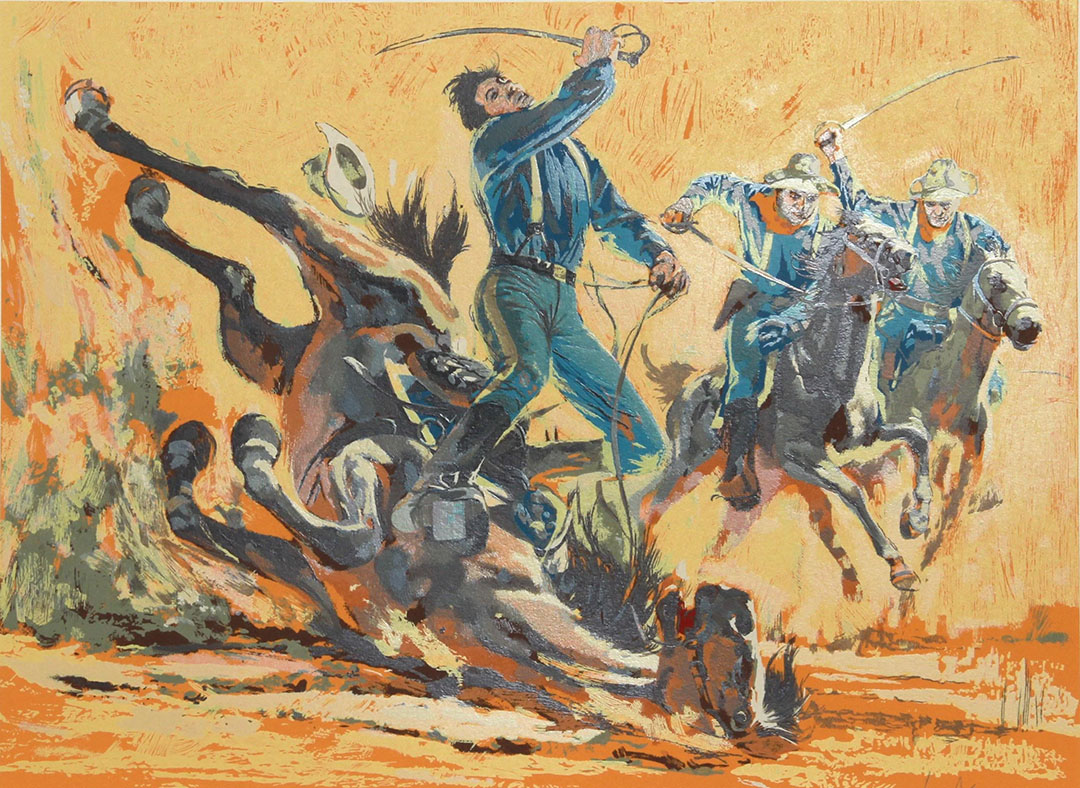
‘For want of a nail the shoe was lost. For want of a shoe the horse was lost. For want of a horse the rider was lost. For want of a rider the battle was lost. For want of a battle the kingdom was lost. And all for the want of a horseshoe nail’ (John Gower’s Confesio Amantis, circa 1390).
GLITCH NUMBER 1 ... A nail comes adrift ... A physically weak captain, who had been stricken with 3-bouts of malaria in the Caribbean, sent to a raw, undeveloped country on a mission for which he lacked sufficient strength.
Hobson was quite a sick man from the day he arrived in New Zealand and a very sick man one month later, having been stricken with a debilitating stroke and uncertain if he would ever recover sufficiently to carry on as Lieutenant-Governor.
Even on the 5th of February, at the treaty grounds, his pallid and sickly expression did not go unnoticed. After the meeting an old chief confronted Hobson and his party as they made their way to their boat, and gazed intently into the Lieutenant Governor’s face for a few minutes. ‘Then in a loud shrill voice he cried out in wailing tones - “Aue he koroheke! E kore e roa kua mate”.
Hobson asked Reverend William Colenso for a translation of what was said, but Colenso was evasive, until pressed by Hobson to tell him. Reluctantly, Colenso told him that the grey-haired chief had said - ‘Alas! An old man. He will soon be dead’ (See The Treaty of Waitangi, by T.L. Buick, pg. 148).
Hobson's pallid and sickly expression didn't go unnoticed by an old chief as Hobson left the Waitangi treaty assembly on the 5th of February 1840.
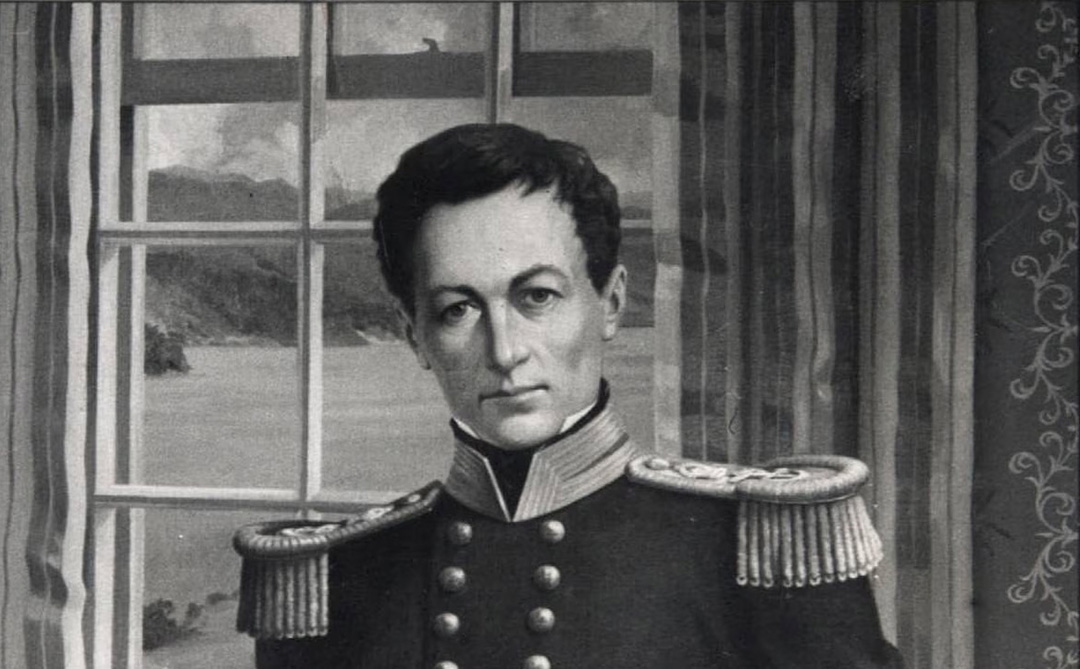
Governor William Hobson, 1792 to 1842, painting by L.C. Mitchell.
‘When Hobson left St. Helena at last he had been at sea on continuous duty for thirteen years and by then he had been made a first lieutenant. In 1821, Hobson commanded the sloop Whim, assigned the task of attacking pirates in the West Indies and it was there that he met the novelist Captain Marryat, furnishing that writer with material for many of his sea stories. Michael Scott, another novelist, made Hobson the hero of a somewhat famous yarn, “Tom Cringle’s Log” which was said to be, in reality, an account of Hobson’s West Indian adventures.
Hobson was afflicted by yellow fever three times, and suffered recurrent headaches for the rest of his life’ (Extracted, in part, from a series of articles in the Waterford News Aug 12/ Sept 16, 1938; from The Oxford Illustrated History of New Zealand, and from Hobson, William 1792 - 1842, by K.A. Simpson, also Dictionary of New Zealand Biography).
Throughout much of the first month in New Zealand, Hobson was running on empty, but pushed himself hard, even though he had few energy reserves to draw upon. Although he always attempted to keep up appearances and exhibit an astute and noble bearing, or put on as brave a face as he could in public, it’s likely he virtually collapsed into bed upon his return, each day, to the seclusion of his cabin aboard H.M.S Herald or other facilities where he stayed.
GLITCH NUMBER 2 ... Incompetent support staff.
Because of illness, Hobson had to rely heavily on his staff, some of whom he barely knew. One such individual was James Stuart Freeman, a 3rd class clerk assigned to Hobson by Governor Sir George Gipps of N.S.W. to act as Hobson’s private secretary.
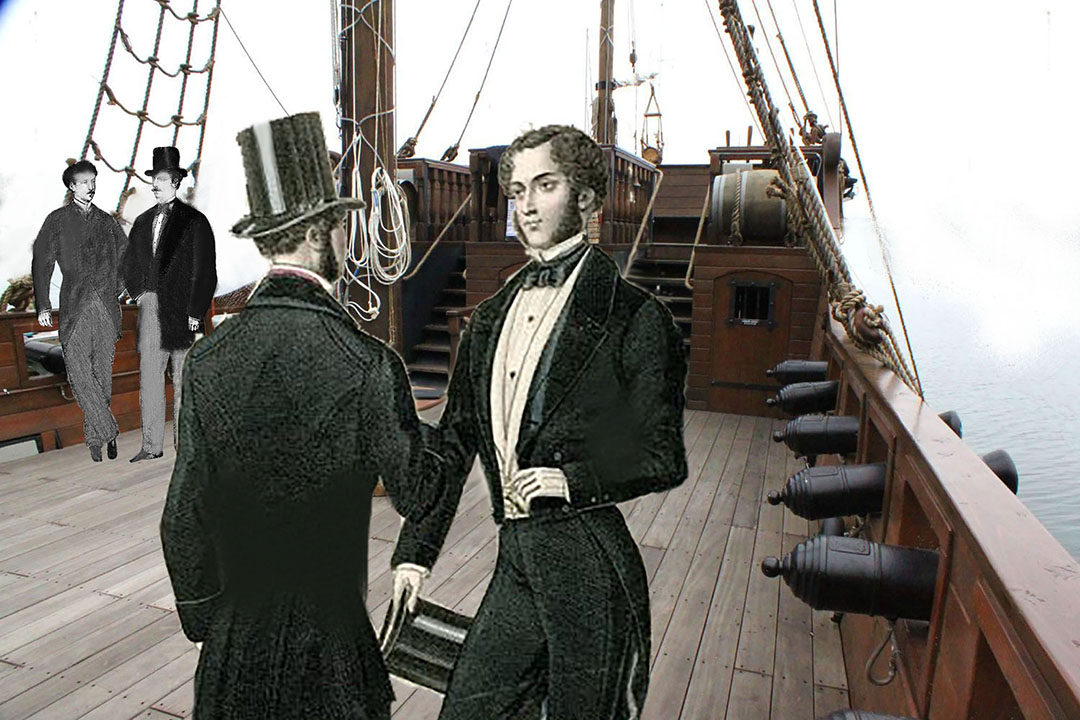
Of some of the staff assigned to Hobson, a future Auckland newspaper editor, Samuel Martin, wrote:
‘Captain Hobson is accompanied by several officers, selected for their known incompetency, by George Gipps. What assistance he is to expect from these persons I do not know, but they are evidently sent to New Zealand because Sir George Gipps has no use for their services here, and was consequently anxious to get rid of them’ (see J Buller, pg. 371).
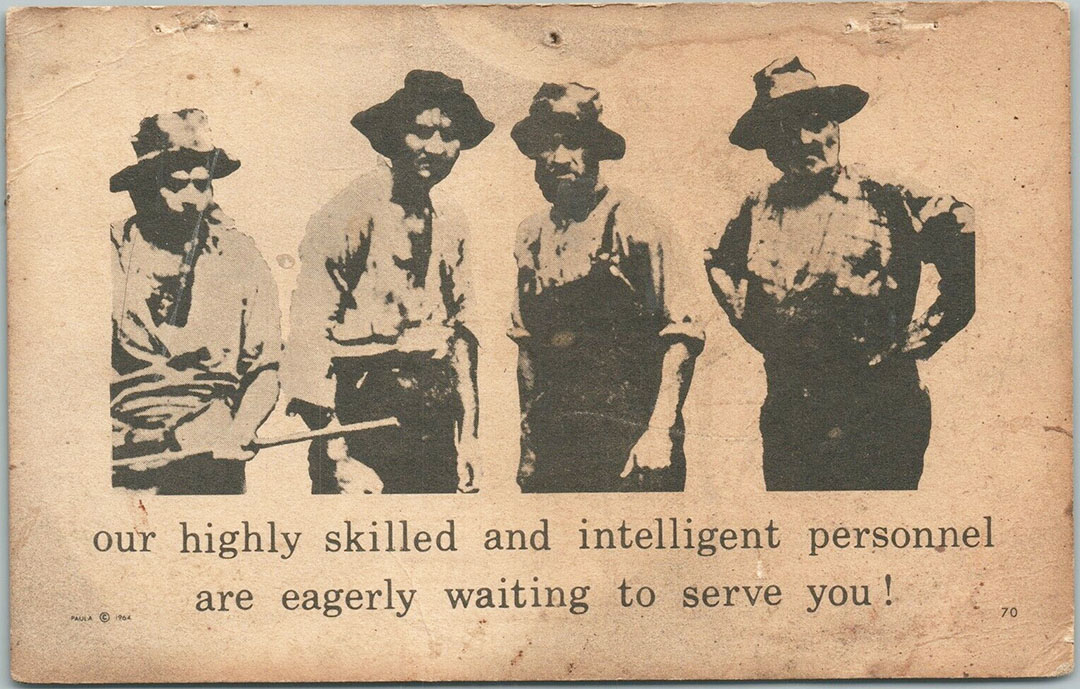
The task of Hobson’s secretary was to keep records, report daily events and make up overseas despatches, such that Hobson’s superiors could stay abreast of developments within the fledgling colony. In many or most cases journal entries or letters and reports had to be hand written in duplicate or triplicate…a copy or two for despatch overseas or elsewhere and one for the Colonial Secretary’s records.
Because of illness or a rigorous travel schedule, Hobson had little hope of supervising Freeman to any great degree and had to rely on Gipps’ earlier judgment that Freeman was competent. He should have been, as he was a well-educated man of about 32-years of age (estimated to have been born in 1808), who had attended Eton Public School and then Oxford University. He had married Eleanor Moslyn on the 24th of October 1836 at Old Church, St Pancras, London, England before emigrating to Australia and taking up clerical duties within the N.S.W Government.
Freeman had a very presentable writing style and a very good command of English, but, having only newly arrived in New Zealand, lacked any knowledge of the Maori language.
GLITCH NUMBER 3. Insufficient supervision of Hobson's private secretary, James Stuart Freeman.
After the Treaty of Waitangi was signed, Freeman felt he should create Formal Royal Style memorial documents in very pretentious, highfalutin language to send exclusively to royalty or dignitaries in foreign governments. All were earmarked only for overseas despatch and all were made up of varying, “composite text” found only in the rough draft English notes and not the Final Draft.
This preoccupation was based upon a somewhat archaic, obsolete tradition and a good example of this flowery kind of salutation is found in the foreword section of the King James version of the Bible:
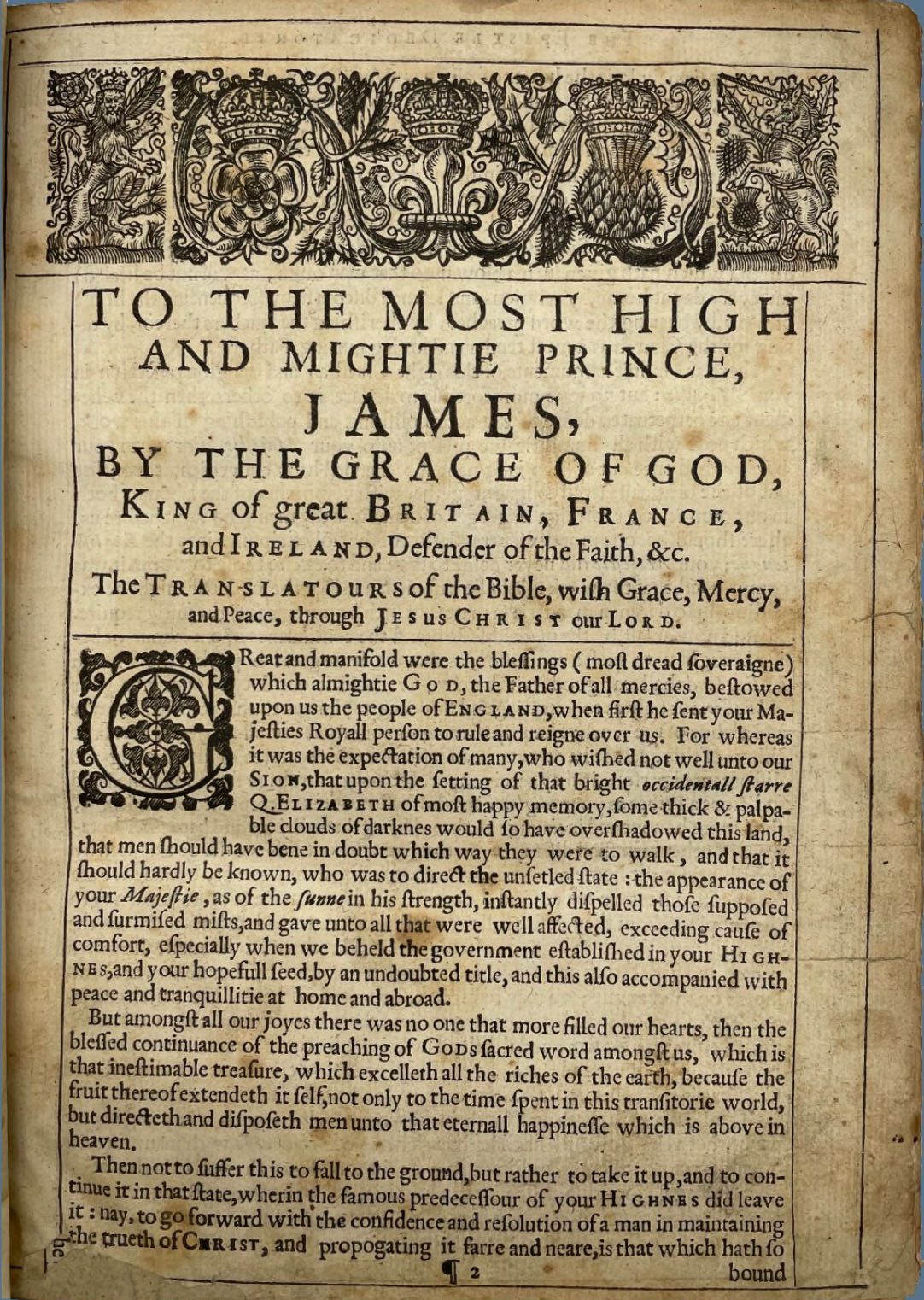
To the Most High and Mighty Prince James,
by the Grace of God,
King of Great Britain, France, and Ireland,
Defender of the Faith, &c.
The Translators of the Bible wish Grace, Mercy, and Peace,
through Jesus Christ our Lord.Great and manifold were the blessings, most dread Sovereign, which Almighty God, the Father of all mercies, bestowed upon us the people of England, when first he sent Your Majesty’s Royal Person to rule and reign over us. For whereas it was the expectation of many, who wished not well unto our Sion, that, upon the setting of that bright Occidental Star, Queen Elizabeth, of most happy memory, some thick and palpable clouds of darkness would so have overshadowed this land, that men should have been in doubt which way they were to walk, and that it should hardly be known who was to direct the unsettled State; the appearance of Your Majesty, as of the Sun in his strength, instantly dispelled those supposed and surmised mists, and gave unto all that were well affected exceeding cause of comfort; especially when we beheld the Government established in Your Highness and Your hopeful Seed, by an undoubted Title; and this also accompanied with peace and tranquility at home and abroad....etc., etc.
Before the ink was even dry on the Tiriti o Waitangi document signed at Waitangi on February 6th 1840, Freeman had gone through the discarded & obsolete ROUGH DRAFT NOTES IN ENGLISH to create his first FORMAL ROYAL STYLE MEMORIAL document. It was sent to Australia in an enclosure aboard the store ship, Samuel Winter, which sailed from the Bay of Islands on the 8th of February 1840.
IN 1972, HISTORIAN RUTH ROSS TRIED TO FATHOM & SORT OUT THE UNHOLY MESS CONCERNING THESE MANY FORMAL ROYAL STYLE VERSIONS OF THE TREATY
Historian Ruth Ross observed the following in 1972, about 20-years before Busby’s Final English Draft, dictated by Hobson, was rediscovered and placed back into the public arena:

Te Tiriti o Waitangi, by Ruth Ross, 1972.
Texts And Translations*
In submissions to the Parliamentary Committee on Fisheries in 1971, the New Zealand Maori Council pressed 'for the recognition and observance of the Treaty of Waitangi in relation to the protection of Maori rights to their traditional resources of shellfish and fishing beds', the council's secretary stating that 'the Treaty of Waitangi was quite explicit in its promises about Maori fishing rights' (1). More recently, the Social Credit League asked the four Maori Members of Parliament jointly to sponsor the introduction of a Bill which, 'if passed, would have the effect of ratifying non-retrospectively the land and citizenship provisions of the Treaty of Waitangi' (2).
These are fairly typical examples of the sort of statement being made about the treaty by politicians, Maori organisations and other interested parties. The fact that the Treaty of Waitangi was an agreement in the Maori language is consistently ignored, the prime example of this being the schedule of the 1960 Waitangi Day Act. Headed "The Treaty of Waitangi", and, according to a former Attorney General, 'included as a schedule to provide convenient access to its information' (3), this agreement in the English language is neither a translation of the Treaty of Waitangi, nor is the Treaty of Waitangi a translation of this English text. The Treaty of Waitangi did not in fact say anything at all about fishing rights. The meaning of its 'land and citizenship provisions' is a matter for interpretation.
James Edward FitzGerald remarked in a debate on the Treaty of Waitangi in the House of Representatives in 1865: 'if this document was signed in the Maori tongue, whatever the English translation might be had nothing to do with the question.' He went on to point out: 'Governor Hobson might have wished the Maoris to sign one thing, and they might have signed something totally different. Were they bound by what they signed or by what Captain Hobson meant them to sign?' (4). To which one would now add the question: Was the Crown bound by what Hobson signed, or by what he assumed its meaning to be?
* This is a study in more detail and with some corrections, of one of the topics discussed by the writer in a paper given at a seminar on the Treaty of Waitangi held at Victoria University at Wellington, 19-20 February 1972.
(1) Auckland Star, Auckland, 30 June 1971.
(2) ibid., 11 July 1972.
(3) ibid., 28 July 1971.
(4) NZPD (1864-6), 292.
Any attempt to interpret the provisions of the Treaty of Waitangi, or to understand what the signatories, both Hobson and the New Zealanders, thought it meant, must review the circumstances in which the agreement was drawn up, taking into account all relevant texts.
Instructions from Lord Normanby, Secretary of State for the Colonies, dated 14 August 1839 authorized Hobson 'to treat with the Aborigines of New Zealand for the recognition of Her Majesty's sovereign authority over the whole or any parts of those islands which they may be willing to place under Her Majesty's dominion' (5). Some of the difficulties which might be encountered in gaining the confidence of the New Zealanders were pointed out, but no draft terms to assist in the drawing up of such a treaty were supplied, either by the Colonial Office or by the Governor of New South Wales, under whose aegis Hobson was to act.
Hobson arrived in the Bay of Islands on 29 January 1840. James Busby, the former British Resident whose appointment ceased with Hobson's arrival, immediately went on board (6) and it was arranged that a meeting of the chiefs would be called at the former Residency at Waitangi for Wednesday, 5 February (7). Circular letters of invitation in the Maori language were printed on the mission press at Paihia early on the morning of 29 January (8).
It has been suggested that the Treaty of Waitangi 'was specifically to retract recognition of the sovereignty of the united tribes' (9) that is, of the confederation supposedly set up by He W[h]akaputanga o te Rangitiratanga o Nu Tireni, Busby's so-called declaration of independence, first signed in October 1835. But the contention that, with the signing of the declaration, 'His Majesty was advised to recognise the new polity', and that Britain now accepted that the sovereignty of New Zealand 'was vested in a defined authority (10) is not borne out by later events.
(5) GBPP, 1840, XXXIII [283], p. 38.
(6) Felton Mathew journal letter entry under 30 January 1840, J. Rutherford, ed., The Founding of New Zealand, Auckland, 1940, p. 25.
(7) Hobson to Gipps, 5-6 February 1840 GBPP, XXXIII, 560 p. 9.
(8) W. Colenso, The Authentic and Genuine History of the Signing of the Treaty of Waitangi, Wellington, 1890, p.11; Colenso, Day and Waste Book, Alexander Turnbull Library (ATL).
(9) Ian Wards, The Shadow of the Land, Wellington 1968, p. 22, n. 3.
(10) ibid., p. 14. Ward's authority for this line of argument appears to be Glenelgs despatch to Bourke of 25 May 1836. This stated: 'With reference to the Desire which the Chiefs have expressed on this Occasion to maintain a good Understanding with His Majesty's Subjects, it will be proper that they should be assured, in His Majesty's name, that He will not fail to avail Himself of every Opportunity of shewing His Goodwill and of affording to those Chiefs such Support and Protection as may be consistent with due Regard to the just Rights of others and to the interests of His Majesty's Subjects'. GBPP, 1837/8, XXI, 680 p.159. This expression in His Majesty's name, of goodwill to the chiefs who had signed the declaration appears to fall somewhat short of advising His Majesty 'to recognise the new polity'.
Hobson was informed by the Colonial Office that Britain acknowledged New Zealand 'as a sovereign and independent state, so far at least as it was possible to make that acknowledgement in favour of a people composed of numerous, dispersed, and petty tribes, who possess few political relations to each other and are incompetent to act, or even to deliberate, in concert' (11). There is no reference to the united (or confederated) tribes (or chiefs), either in the main body of Hobson's instructions, or in further instructions written in answer to a query from Hobson, in which he had mentioned that the 'declaration of independence of New Zealand was signed by the united chiefs of the northern island only (in fact, only the northern part of that island)' (12).
The Secretary of State's continued avoidance of any mention of the united or confederated chiefs or tribes, or of the declaration of independence, his qualification of the sovereignty which Britain recognised as vested in the New Zealanders, surely dispels any theory that Hobson was instructed to treat with the 'confederation' (13) for the cession of New Zealand sovereignty.
Hobson knew of the declaration of independence from his earlier visit to the Bay of Islands in 1837, when he had shown himself well aware of the hollowness of its pretensions (14). His policy in 1840 of getting as many declaration signatories as possible to sign the treaty was no doubt wise, but it was certainly not his intention to invite only the confederated chiefs to the Waitangi meeting. He informed Gipps on the evening of 5 February that he had immediately on his arrival at the Bay of Islands 'circulated notices, printed in the native language, that on this day I would hold a meeting of the chiefs of the confederation, and of the high chiefs who had not yet signed the declaration of independence...' (15). In fact, the printed circulars invited only the chiefs of the confederation (16) to the meeting. The invitation was issued over Busby's name, (17) and there is other evidence suggesting that he contemplated a meeting only of the confederated chiefs (18). Busby had always exaggerated the viability of the confederation. His later claims about the Treaty of Waitangi were similarly distorted. Posterity's acceptance of Busby's claims to treaty authorship has in large part been responsible for today's chaotic misunderstanding about the Treaty of Waitangi.
(11). GBPP, 1840, XXXIII [238], pp. 37-38.
(12) ibid., p. 42.
(13) Te W(h)akamienga o nga Hapu o Nu Tireni, which was supposedly set up by He w(h)akaputanga o te Rangitiratanga o Nu Tireni, i.e. Busby's declaration of independence. This was signed initially on 28 October 1835 by 34 chiefs, nearly all from the Bay of Islands and its immediate environs. (The 35th signature was that of Eruera Pare, the kai tuhituhi, the writer who inscribed the document and the signatories names.) Later signatures, totaling 18, were mainly of Hokianga and Kaitaia chiefs, two notable exceptions being Te Hapuka of Hawkes Bay and Te Wherowhero of Waikato, whose name was the last to be added, in July 1839.
(14) Hobson to Bourke, 8 August 1837, GBPP, 1837/8, XL, 122, p. 4.
(15) GBPP, 1840, XXXIII, 560, p. 9.
(16 nga rangitira o te Wakaminenga o Nu Tireni - see reduced facsimile of the copy sent to Tamati Waka Néné, T Lindsay Buick, The Treaty of Waitangi, New Plymouth, 1936, f.p. 112. Colenso's ledger and Day and Waste Book, ATI, each shows only the one printing of 100 copies of 'Circulars for assembling Natives at Waitangi', thus ruling out the possibility of a differently worded version having also been printed for circulation to 'the high chiefs who had not yet signed the declaration'.
(17) Na te Puhipi.
(18) See Mathew's journal letter, entry for 30 January 1840; 'From Busby we learned it will not be possible to assemble the Chiefs of the "confederation" under Ten days...' Rutherford, p. 25.
The English versions
Official despatches yield no clues about how the Treaty of Waitangi was drawn up, Hobson's report to Gipps after the first day's proceedings at Waitangi on the 5 February merely noting that the meeting of the chiefs had been called 'for the purpose of explaining to them the commands I have received from Her Majesty, and of laying before them the copy of the treaty which I had to propose for their consideration' (19).
In later years, Busby more than once claimed to have had the major part in drawing up the Treaty of Waitangi. In 1858, in an Auckland newspaper, he wrote: 'As I, myself, drew that Treaty...' (20). Two years later, in his attack on Sir William Martin's The Taranaki Question, Busby related that 'when it became necessary to draw the Treaty' Hobson was too unwell to leave the ship, so sent two of his officers to Busby with 'some notes, which they had put together as the basis of the Treaty'. Busby 'stated that I should not consider the proposititions [sic] contained in those notes as calculated to accomplish the object', and offered to prepare a draft himself. 'The draft of the Treaty prepared by me', Busby claimed, 'was adopted by Capt. Hobson without any other alteration than a transposition of certain sentences, which did not in any degree affect the sense' (21). Returning to the subject in 1865, he was even more dogmatic: 'The Treaty as it now exists, with exception to the transposition of two sentences, was accordingly drafted by him [referring to himself], and was sent to the Revd. Henry Williams the head of the Church Mission for translation' (22).
The notes brought to him by Hobson's officers have survived and are reproduced in Fac-similes of the...Treaty of Waitangi (23). There are two sets of these notes. The first, in Hobson's handwriting, is a draft of a preamble only. The second set of notes, in the handwriting of J. S. Freeman, (24) Hobson's secretary, comprises the draft of a differently worded preamble and of three articles. Also reproduced in the Fac-similes is another set of articles, in Busby's hand. This is a fair copy of a draft of the Articles of a Treaty with the Native chiefs submitted to Hobson, 3rd Feby. 1840 (25).
(19) GBPP, 1840, XXXIII, 580, p. 9.
(20) Southern Cross, Auckland, 25 June 1858.
(21) J. Busby, Remarks upon a Pamphlet..., Auckland, 1860, pp. 3-4.
(22) J Busby, 'Occupation of New Zealand 1833-1843', typescript, Auckland Institute and Museum Library, p. 87.
(23) Wellington, 1877; reprint 1892; new edition, 1960.
(24) It is not always easy to identify the handwriting of minor officials, as they seldom sign the letters they write. It seemed likely that the second set of notes in the Fac-similes was in Freeman's hand, many of Hobson's despatches being in the same handwriting. Definite identification became possible with the chance finding of a letter to J. J. Galloway of 5 June 1840 signed by Freeman 'for the Colonial Secretary', IA I, 40/191, National Archives, Wellington.
(25) Ms 46, F 6, Auckland Institute and Museum Library.
(21, 22, 23, 24, 25) Additional commentary by Martin Doutré: When Ruth Ross wrote her paper in 1972, she could not know that an additional English treaty draft would be discovered in 1989 amidst family papers, by descendants of 1840's solicitor, Henry Littlewood. The rediscovered "final lost draft" was in the handwriting of James Busby and was virtually a perfect mirror image of the Maori Treaty text, 'without any other alteration than a transposition of certain sentences, which did not in any degree affect the sense'.
According to Henry William's 'Early Recollections': 'On the 4th of February, about 4 o'clock p.m., Captain Hobson came to me with the Treaty of Waitangi in English, for me to translate into Maori, saying that he would meet me in the morning at the house of the British Resident, Mr. Busby; when it must be read to the chiefs assembled at 10 o'clock' (26). Unfortunately the treaty text given to Williams to translate does not appear to have survived (27). Williams translation was read and discussed at the first day's meeting at Waitangi and then handed over to Richard Taylor who recorded in his journal under date 5 February 1840: 'I sat up late copying the treaty on parchment and I kept the original draft for my pains' (28). When it was suggested in the House of Representatives in 1865 that the original treaty was written by Mr. Taylor, Hugh Carleton, William's son-in-law, made it quite clear that only the handwriting was Taylor's: 'An alteration was made while the draft was under consideration, and Mr. Taylor volunteered to write out the whole afresh. Colenso, also in the House, agreed that this was so' (29).
It would appear, therefore, that the treaty text signed at the second day's meeting at Waitangi differed in at least one respect from the draft which had been considered by the chiefs during the previous day. Was the alteration one of any consequence? Was there in fact only one alteration? Were the chiefs informed of the change(s) made? Carleton's bland explanation, apparently quite acceptable to his parliamentary colleagues, leaves many questions unanswered today. But this much is clear: the drafts, in English or in Maori, were merely drafts; it is the Maori text which was signed at Waitangi on 6 February 1840, and at other places at subsequent dates, by Hobson (and/or others acting for him) and a total of 500 (30) New Zealanders, which is the Treaty of Waitangi.
(26) Hugh Carleton, The Life of Henry Williams, Auckland, 1877, II, 12.
(27) It is not among the Williams papers in either the Auckland Institute and Museum Library or the Alexander Turnbull Library.
(28) Journal of the Rev. Richard Taylor, vol. 2 p. 189, typescript, Auckland Institute and Museum Library. No trace has been found of this 'original draft', i.e. William's translation.
(29) NZPD (1864-6), 292.
(30) Give or take one or two. See below, n. 41.
What then is 'the English version'? In all, Hobson forwarded five English versions to his superiors in Sydney or London (31). The differences in wording of three of these versions are minor, of significance only because there are differences; two of the texts have a different date, (32) differ substantially in the wording of the preamble from the others, and from each other at one very critical point in the second article (33). A comparison of all five English versions with the Maori text makes it clear that the Maori text was not a translation of any one of these English versions, nor was any of the English versions a translation of the Maori text.
The relationship of these five English versions with the draft notes printed in Fac-similes was as follows: Hobson's draft became the preamble of three of the English versions, (34) the preamble of the other two versions (35) following the preamble in the Freeman draft (36). There is no mention of forests and fisheries in one version, (37) but otherwise the articles in all five versions are the same and draw heavily on Busby's draft, shorn of the major part of his wordy conclusion. Busby's articles, however, were in large measure an expansion of those in Freeman's notes. Busby's claim to have 'drawn' the treaty is thus a considerable exaggeration even if applied to the various English versions. His contribution to the Maori text of the Treaty of Waitangi itself was, as we shall see, minimal.
(31) These were enclosures in the following despatches (except in the parentheses in (d), page references are to the English versions, not to the despatches in which they are enclosed):
(a) Hobson to Gipps, 5-6 February 1840, of which a copy was enclosed in Gipps to Secretary of State, 19 February 1840 CO 209/6, pp. 52-54 and printed in GBPP, 1840, XXXIII, 560, pp. 10-11. (CO 209 is on microfilm, National Archives, Wellington) Note: All of this is available at the University of Auckland Library and Microfilm section.
(b) Hobson to Secretary of State, 40/1 of 17 February 1840, CO 209/7, pp. 13-14[v]; in the printed version, this despatch is dated 16 February. GBPP, 1841, XVII. 311, p. 10.
(c) Duplicate (dated 16 February 1840) of 40/1, G 30/1, pp. 29-32, National Archives, Wellington.
(d) Duplicate of Hobson to Secretary of State, 40/3 of 23 May 1840, G 30/1, pp. 75-78. (The original of 40/3 dated 25 May did not enclose an English version - see CO 209/7, pp. 55-64).
(e) Hobson to Secretary of State, 40/7 of 15 October 1840, CO 209/7, p. 178, printed GBPP, 1841, XVII, 311, pp. 98-99, where it is headed 'Translation' and follows the Maori text, which is headed 'Treaty'. But in the original 'certified copy of the Treaty both in the English and Native language' on CO 209/7, p. 178, the heading 'Treaty' applies to both English and Maori texts.
(32) The version enclosed with duplicates of 40/1 and 40/3 are both dated 'on the fifth day of February'; hence the wording 'by a Treaty bearing Date the Fifth day of February' in Hobson's proclamation of sovereignty over the North Island, 21 May 1840.
(33) See below an n. 37.
(34) Those forwarded to Gipps with the report of 5-6 February 1840 and to the Colonial Office with the originals of 40/1 and 40/7.
(35) Those forwarded with duplicates of 40/1 and 40/3.
(36) Of which the wording is as follows: Her most Gracious Majesty Victoria Queen of the United Kingdom of Great Britain and Ireland regarding with deep solicitude the present State of New Zealand arising from the extensive settlement of British Subjects therein - and being desirous to avert the evil consequences which must result both to the Natives of New Zealand and to Her Subjects from the absence of necessary Laws and Institutions has been graciously pleased to empower and authorize me William Hobson a Captain in Her Majesty's Royal Navy, Consul and Lieutenant Governor in New Zealand to invite the Confederated Chiefs to concur in the following articles and conditions.' Cf, text of the agreement signed at Waikato Heads and Manukau in mid-March and late April 1840, p. 156 below.
(37) That enclosed with the duplicate of 40/1.
From the very beginning, confusion has reigned over what was the translation for which. For this Henry Williams himself was initially responsible. The English version forwarded with Hobson's first New Zealand despatch to the Secretary of State (38) was endorsed by Williams: 'I certify that the above is as Literal a translation of the Treaty of Waitangi as the idiom of Language will admit of''. Yet this is palpably incorrect; Williams knew better than anyone else that the Treaty of Waitangi was a translation of an English draft, not vice versa.
Note by Martin Doutré: Historian Ruth Ross seems to have overlooked the fact that Reverend Henry Williams sent a handwritten copy and 3 printed copies of the Maori language, Te Tiriti o Waitangi in that despatch enclosure. He was indeed certifying his 'TRANSLATION'.
From the facts available it is apparent that what was given to Williams to translate about 4 p.m. on 4 February was a composite version of the draft notes of Hobson, Freeman and Busby. Whether this composite text was compiled by Hobson, or by his secretary or was their joint effort, it cannot have been put together until after Busby's draft articles had been 'submitted to Capt. Hobson' sometime on 3 February. The existence of a number of other English versions, all of them composite versions of the same draft notes, suggests a certain element of chance, as well as haste, in the compilation and selection of the version actually handed over for translation. That these other composite texts were afterwards forwarded at various times to Hobson's superiors, in each instance as though the text in question had official status - that is, was either a translation of the treaty, or the text from which the treaty had been translated - suggests a considerable degree of carelessness, or cynicism, in the whole process of treaty making.
Note by Martin Doutré: Historian Ruth Ross would have understood perfectly what English draft was handed to Reverend Henry Williams for translation into Te Tiriti if she had lived to see the Final English Draft's rediscovery in 1989.
(38) 40/1 of 17 February 1840, CO 209/7, pp. 13-14[v].
Hobson does not appear to have noticed the differences in the various English texts forwarded with his despatches, or, if he did notice them, thought them of no account. If the differences were noticed in the Colonial Office, it was perhaps supposed that Hobson's despatch of 15 October 1840 with its enclosure of 'a certified copy' of the Treaty both in English and the Native language; with names inserted of the Chiefs and witnesses who signed it (39). This 'long roll of parchment' made quite an impression in the Colonial Office, (40) but at some stage the greater portion of it, comprising a list of 512 signatures (41) was taken off and apparently lost, leaving only the 'certified' Maori and English texts (42). Set out side by side, the heading 'Treaty' applying as much to one as to the other, these were no doubt taken to be alternative texts, one a translation of the other. In fact, the Maori text was that of the Treaty of Waitangi to which, ultimately, approximately 500 (43) names were appended over a period of seven months (44). The English text, though closely resembling two of the earlier versions, differed slightly in wording here and there not only from these two but also from the English text to which thirty-nine names had been appended at Waikato and Manukau in March and April 1840.
No contemporary mention has been found of the fact that although the great majority of treaty signatories signed the Maori text of the Treaty of Waitangi, there were also these few signatures to an agreement in the English language. In the present century, most discussion ignores the fact that the treaty of Waitangi was an agreement in the Maori language. Yet how can the English text be thought to have any validity at all? True, Hobson signed the Waikato - Manukau agreement, but on at least one point of pre-emption, he was mistaken about its actual meaning. It is impossible even to guess what the thirty nine men of Waikato and Manukau thought the document meant. There seems to have been no copy of the Maori text at hand at the time and no record has survived of how the English text was explained to them. Even the date (or dates) in March when the Waikato names were added is unknown.
Note by Martin Doutré: We now know that Reverend Robert Maunsell read the only authorised text in the Maori language that Maori chiefs were permitted by Hobson to hear and consider. Because Maunsell's government issued sheet in the Maori language did not arrive in time, Maunsell was forced to innovate in order to conduct his assembly before 1500 Maori. He had "Printed Maori" sheets, one sent it seems by "The Secretary" (Freeman) and others delivered by Captain Gordon Brown weeks before his April 11th 1840 meeting. Forensic evidence proves conclusively that Maunsell's "make-do" treaty was a Printed Maori sheet (the text) pinned and wax-glued to the Formal Royal Style English sheet (the repository for overflow signatures that would not fit on the Maori language sheet). Both sheets are signed by Maunsell.
(39) Hobson to Secretary of State, 15 October, 40/7, CO 209/7, pp. 102-102[v].
(40) See James Stephen's minute of 9 March 1841 to Vernon Smith, ibid., p. 103[v].
(41) At this stage Hobson appears to have had in his possession the following sheets of the treaty: the Waitangi sheet with the Kaitaia signatures also attached, the two Bay of Plenty sheets, the Herald sheet, the Cook Strait sheet and the East Coast sheet, with a total of 484 names. If one adds the 39 names on the Waikato - Manukau agreement in the English language, the total is 523. It would thus seem that either in New Zealand or in the Colonial Office eleven names have been omitted in the process of copying and counting perhaps deliberately for as 'signatures', some are indeed of very doubtful validity. The Manukau - Kawhia sheet, with 13 more names, came to hand later, and there is also a printed sheet (of the Maori text) with 5 more name, undated, making a grand total of 541, by my count, 502 (including both Te Rauparaha's signatures) being appended to the Maori text, 39 to the agreement in the English language.
(42) CO 209/7, p. 178.
(43) See n. 41 above.
(44) From the first signatures, taken at Waitangi on 6 February, to the last dated signature, at Kawhia on 3 September. The signatures on the printed sheet may have been added later still.
IN THE PASSAGE OF OVER 50-YEARS SINCE RUTH ROSS WROTE HER ANALYSIS, WHAT DO WE KNOW FOR SURE NOW?
New Zealand historians, whether they know it or not, have had access to all the information they need to clean up this mess of treaty-confusion for about the past 80-years or so.
Due to the danger posed by German bombing raids over England during WWII (1940s) and the possibility of Hobson's despatches of 1840-42 being destroyed, the document originals were shipped back to New Zealand for safe-keeping. These are found in thick volumes at The National Archives, Wellington, New Zealand under the title, Repatriated Despatches G 30. Also, these despatch documents are available on microfilm at many centres around New Zealand.
Accompanying Hobson's despatch enclosure documents, viewable on microfilm, are the microfilmed documents of James Reddy Clendon (U S Consul) and also Commodore Charles Wilkes (head of the United States Antarctic Expeditionary Squadron ... 1840). Both of these individuals, in their official capacities, asked for and received (in February & March 1840) the true FINAL ENGLISH DRAFT text of the Treaty of Waitangi from Hobson, as well as the MAORI LANGUAGE TEXT translated from it ... for transmission to their superiors in the United States.
The English wording that they had in their possession and transcribed proves conclusively that they had in their hands none other than the LITTLEWOOD DOCUMENT, lost thereafter for 149-years until found in the papers of Henry Littlewood (Clendon's solicitor) by Henry Littlewood's great-grandchildren (1989).
Even Ruth Ross could have read the Final English Draft of the Treaty (the mother document of Te Tiriti o Waitangi) during her lifetime!.
See: Auckland Institute and Museum Library: Micro # 51. Despatches from the U.S. Consul to the Bay of Islands and Auckland, 1839-1906: Roll 1, May 27, 1839 - Nov. 30, 1846, also available at the University of Auckland Library).
See: Papers of Charles Wilkes 1837 - 1847, U.S.S. Vincennes Letter Book, copy of despatch 64, Microfilm 1262, University of Auckland Library, pp. 163 - 164, originals held at the Kansas Historical Society, Topeka Kansas, U.S.A.).
With regards to these Formal Royal Style versions concocted only from discarded rough draft English language notes, we now know that at least 7 of these were created by Freeman between February and July 1840 and they were all different in wording to a greater or lesser extent. All were created from a hodge-podge mess of scribbles and deletions, written between February 1st to the 3rd, 1840, with nothing from the Final English Draft of the 4th. Any historian can go through the "rough draft notes" and verify this as an indisputable fact. The rough draft notes do not contain a finalised text that can be handed to a translator.
Without adequate supervision or a stringent directive to remain singularly consistent in despatching only one authorised, strictly worded English version of the Treaty of Waitangi, Freeman produced only several Formal Royal Style variations. For these, he simply dipped, at will, into the 12-pages of superseded and now obsolete English language rough-draft notes in his possession and extracted text to make ad-hoc "composite" treaty versions.
During February and March of 1840, he mostly used Hobson’s Preamble. Thereafter, he went through a phase where he tagged on the Preamble he, himself, had produced around the 1st of February 1840, when Hobson was too jaded and ill to attempt working out treaty draft text himself.
After April 1840, Freeman manufactured at least 3 of these new treaty versions for despatch using his own grandiose Preamble, ‘Her Most Gracious Majesty Victoria Queen of the United Kingdom of Great Britain and Ireland regarding with deep solicitude…’ etc. He seems to have been quite enamored with this text and, possibly, wished to be immortalised by submitting this, his own literary creation, to dwell forevermore amidst the illustrious, treaty related papers of the British Parliament or U.S. Congressional archives.

James Stuart Freeman seemed to have a fixation upon providing Hobson’s superiors with English treaty texts that rose above the coarse and simple wording of The Final English Draft. Knowing that the important founding documents of the colony were to come under the critical gaze of British lords and ladies or, perhaps, Queen Victoria herself, Freeman seemed intent upon upgrading the otherwise simplistic, Final English Draft text into suitably pretentious language, befitting high stations of the realm. The more beautiful embellishments of language had, earlier, been discarded at the last drafting session, when the English wording was severely edited-back and refined for fluid translation later into the Maori language. Buick paraphrases Reverend Henry Williams in writing:
The task of translation was necessarily a difficult one, it being essential that there should be a complete avoidance of all expressions of the English for which there was no equivalent in Maori (see The Treaty of Waitangi, by T.L. Buick, pg. 113).
Seemingly, in Freeman’s view, just because it became essential to use simple English for translation purposes, this didn’t mean that it had to so remain when presented to Her Majesty.*
To the best of our knowledge Freeman never showed any inclination towards providing The Final English Draft version for despatch. On a couple of occasions Hobson initialed the top corner of a treaty despatch document, which was otherwise fully in Freeman’s handwriting. Other times, Freeman simply signed Hobson’s name for him.
*Footnote: Dr. Phil Parkinson refers to: ‘the formal Royal Style (quite properly employed by Freeman, and not an eccentric case of ‘pride’ as you seem to assert) and sent to Gipps in the despatches of the 5th and 6th February and sent on the 8th February in the Samuel Winter before being forwarded to Normanby on the 19th, now at PRO CO 209/7, 13-15. (Letter to Martin Doutré, 1st November 2004).
To which one must respond that, the injection of a ‘Formal Royal Style’ copy into the treaty process could be considered fine, as long as that version is accorded no legal validity and, by its very existence, didn't nullify or confuse the original Tiriti O Waitangi understanding.
The internationally-accepted legal agreement, which had to be solely in the Maori language, was set in stone at the assembly on the 6th of February 1840 and can’t be tampered with or affected by Freeman trying to accommodate the perceived delicate sensibilities of royalty. If such catering was considered necessary or traditional, then it was up to Freeman to ensure that, never the twain shall meet and to isolate the contract from the poetry as two separate entities.
Once Hobson had secured a treaty with the Ngapuhi Maori chiefs he seemed patently disinterested in what memorial-document versions Freeman was manufacturing for despatch to Australia, Britain or the United States. As far as Hobson was concerned, there was only one (de facto) treaty contract and it was written fully in the Maori language. English versions were simply drafts or back-translations and no English version was ever intended, by either Hobson’s government or Shortland’s interim government, to be signed by the chiefs.
Hobson had clearly stated in his letter instructions to Major Bunbury:
The treaty, which forms the base of all my proceedings was signed at Waitangi, on the 6th February, 1840, by 52 chiefs, 26 of whom were of the Confederation, and formed a majority of those who signed the Declaration of Independence. 'This instrument I consider to be de facto the treaty, and all signatures that are subsequently obtained are merely testimonials of adherence to the terms of the original document' (see: The Treaty of Waitangi, by T.L. Buick, pg. 162).
Glitch number 4. Hobson has a stroke.

Hobson has a paralysing stroke only 1-month after arriving in New Zealand.
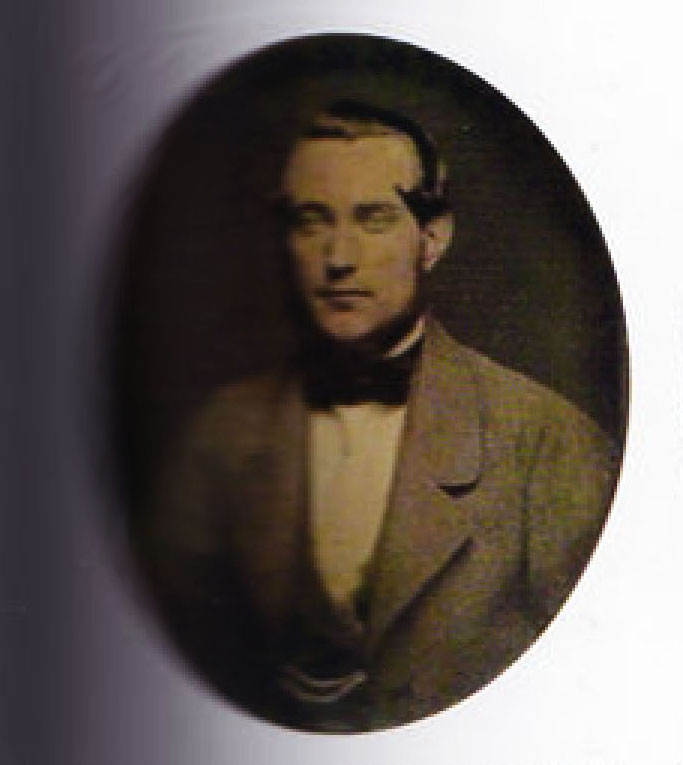
The only known photograph of Felton Mathew, Surveyor General of New Zealand.
Felton Mathew states in his diary entry for the 1st of March 1840 concerning this incident aboard H.M.S. Herald, anchored in the Waitemata Harbour, at (nowadays) Auckland, New Zealand. A violent storm of hurricane proportions had lashed the ship through the preceeding day and especially the night hours till the dawn of the 1st, causing much shipboard damage. Captain Nias and the ship's crew, undoubtedly including Captain Hobson, had been up all night, ensuring the ship was not driven onto the shore and wrecked.
Felton Mathew wrote:
'I was after breakfast walking the quarter deck with Capt Hobson – and he was endeavoring to quiet my apprehension for the storeship – and was in perfect health & spirits – I went down to my cabin and in five minutes afterwards he was attacked with paralysis, losing temporarily the use of one side and partly of his speech. – He was immediately placed in bed and proper means of relief resorted to, and is now at noon decidedly better; but still it is so awful a complaint, and one attack is so certain to be followed by another, that his fitness for his office is at one blow destroyed. Of this he is aware, and I could not but admire his manly firmness and his high principle, when on going in to see him, he told me that at once he had made up his mind that he was unfit for the cares of office, and must resign and return to Sydney – Poor fellow, it is a sad blow for him – and what a shock for his wife. This untoward event has at once laid level all our plans – and we know what course we must adopt.'
2nd of March 1840:
Captain Hobson is I fear rather worse than better and has just been both cupped & blistered (cupping therapy for paralysis) which with so feeble a constitution as his, must tend very much to debilitate him. I have very serious apprehension for him and am very desirous that we should return to the Bay as soon as possible, in order that Shortland, who is his private friend, may decide what should be done with him -
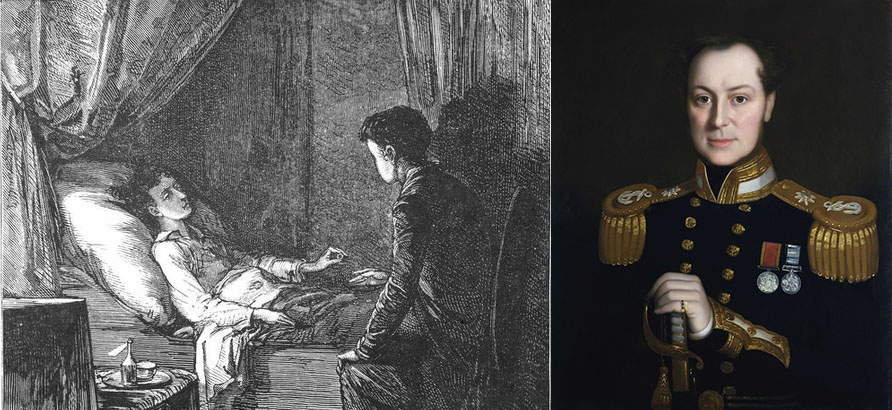
Lieut-Governor of New Zealand, William Hobson, lies stricken with a debilitating stroke aboard HMS Herald on March 1st 1840 and is paralysed down his right side. His stroke was largely the result of terrible arguments with antagonistic Captain Joseph Nias (right), who resented having to transport Hobson and his government emissaries around New Zealand, while there was a nice little war brewing in China that he was anxious to attend.
During most of his first month in New Zealand, Hobson felt like death warmed over. The constant fights with Nias, apart from sapping Hobson’s energy, also seemed to have an effect on his self-confidence. At the same time, being outside his own patch, or a stranger in a strange land, and fully reliant on the missionaries to organise itineraries of where to go and who to see, forced Hobson to be constantly seeking advice from others. He was trying to organise order out of chaos in an undeveloped country. His situation of being hopelessly at the mercy of go-betweens to arrange access to the isolated chiefs he needed to talk to, as well as his ever-present uncertainty related to what could be accomplished next, was the source of some criticism towards Hobson. Felton Mathew writes concerning events of February 27th 1840:
'Our leader’s movements - I shall not call them plans, - for he has none - are very feeble and vacillating - And like a man who is less to his station, he seeks to strengthen his opinion by the judgement of others - and is perpetually seeking what he calls information, from the missionaries & others, who are the very parties interested in misleading him: And yet he is obstinate as a pig too, and thinks that no one knows anything but himself'.
And again for March 7th, a week after Hobson had suffered his stroke:
'We have had such an explosion this morning between the two Captains, who are both obstinate, wrongheaded fellows, & as fit to act together as fire and toe - The quarrel has been very violent, and the consequence has been the framing of a set of minutes of the conversation that took place, for the purpose of transmitting them to Govn George Gipps - Where this matter may end, tis impossible to foresee - it may occasion our recall to Sydney - perhaps even to England - the immediate effect in that the Govn says we must all leave the ship this eveng - Meantime this is the way in which the public service is conducted, by two men, neither of whom are at all qualified for the duty to which they have been appointed - Nothing but broils have occurred - and the whole affair has been one scene of folly and imbecility from beginning to end - Captn Hobson will kill himself in six months, if he continues here, as it appears he has determined to do - You will see [from an earlier letter] how I admired the manly way in which, when he was first attacked [by stroke induced paralysis], he formed at once the resolution of resigning the Govn and returning to Sydney. No sooner, however, does he become a little better, than he alters his intention, still clinging to the loaves and fishes/- this perhaps natural; but alas, poor human nature! - Captn Nias has certainly shewn great want of feeling and much indelicacy in wishing to hurry Hobson out of the ship:- but the latter again is a most disagreeable person to have anything to do with, and has been in many things much to blame - I do not think that any officer will serve with him for twelve months - It is very doubtful if I shall do so, for so long a period.'
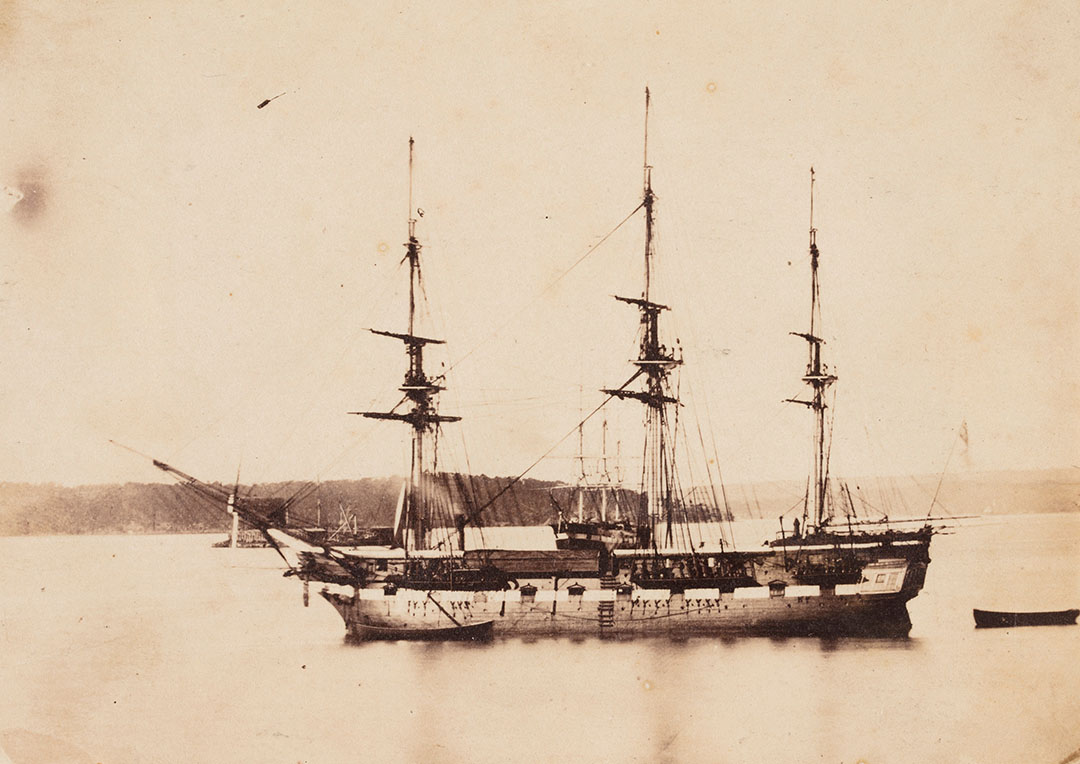
HMS Herald brought William Hobson to New Zealand from Australia. He was commissioned by the British Government with the task of securing a treaty with the Maori chiefs and the formation of a British colony under Queen Victoria. The ship is pictured at anchor in Sydney Harbour, Australia in 1857.

HMS Herald anchored at Sylvan Cove, Steward Island, New Zealand in 1840. The drawing was done by Edward Marsh Williams, son of Reverend Henry Williams and co-translator of the Final English Draft of the Treaty of Waitangi into the Maori language. Edward was considered to be a 'scholar par excellence' in the Maori language, having been raised bilingual in English & Maori. Hence his assignment to convene treaty assemblies in New Zealand's South Island.
After Lieutenant Governor William Hobson had his stroke and lay paralysed and despondent, trying to recuperate, he was obliged to hand the reins of power to Willoughby Shortland.
All of Hobson’s hopes were dashed and his plans were in disarray. He could no longer figure on being present at treaty assemblies around the county where, as the Queen’s duly appointed representative, his presence could wield much influence in inducing the chiefs to sign the treaty. Reverend Richard Davis and his family were looking after Hobson at Waimate and nursing him back to strength.
After about the 15th of March 1840 Hobson’s main focus was to attempt to pencil a short note to his wife Eliza in Australia, using his paralysed, but slowly improving, right hand.
Glitch number 5 . A paralysed Hobson is asked, by Freeman, to sign a Formal Royal Style document.
At some point at the height of Hobson’s early illness and paralysis down his right side and lingering close to death, James Stuart Freeman had placed one of his ad-hoc, composite versions of the treaty in English (Formal Royal Style) under Hobson’s nose and asked him to sign it. This request by Freeman would have been at some time between the 2nd and 3rd of March at the height of Hobson's illness.
H.M.S. Herald was shortly to return to Australia for much needed provisions. Seemingly, Freeman wanted another memorial document to be included in enclosures destined for Governor, Sir George Gipps.
Hobson wrote the following to Governor George Gipps on the 25th of May 1840, speaking of his paralysing stroke and what caused it:
Unfortunately on the 1st of March I was attacked by violent illness, occasioned by harassing duties and long exposure to wet, which partially paralysed my right arm, and by this circumstance combined with a want of provisions on board the Herald, induced me to return to the Bay of Islands, and obliged Captain Nias to proceed to Sydney for supplies.'
A very feeble and sickly Hobson had attempted to add the signature using his left hand, but the result was terrible and the signature was the worst, most-tortured Hobson ever executed on any known document.
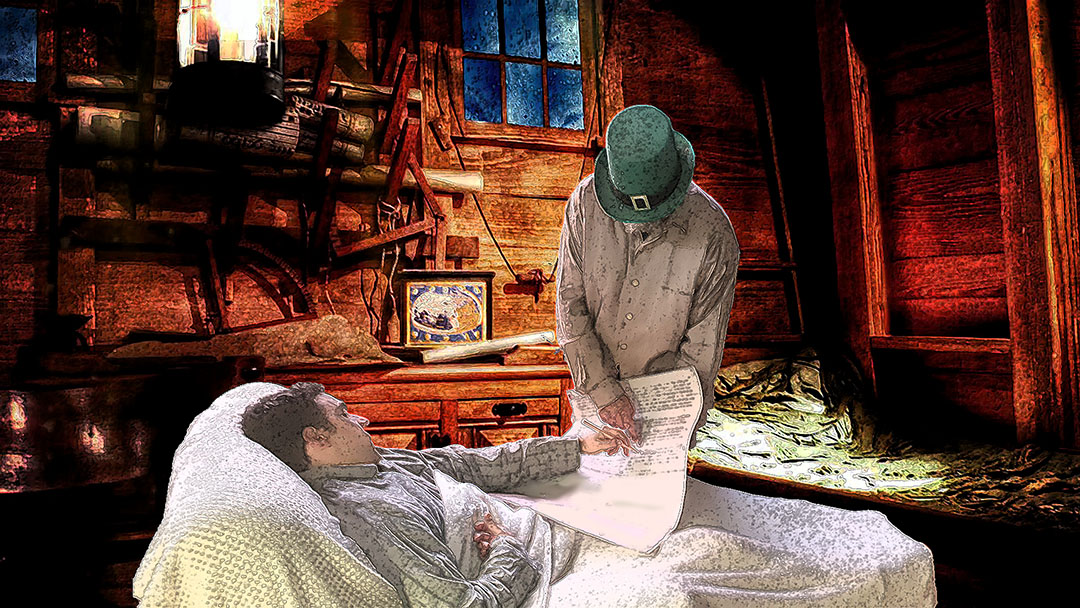
Freeman had, obviously, written this English language treaty document up for despatch overseas, as none such were ever intended to be sent by the government for use at the treaty signing assemblies.
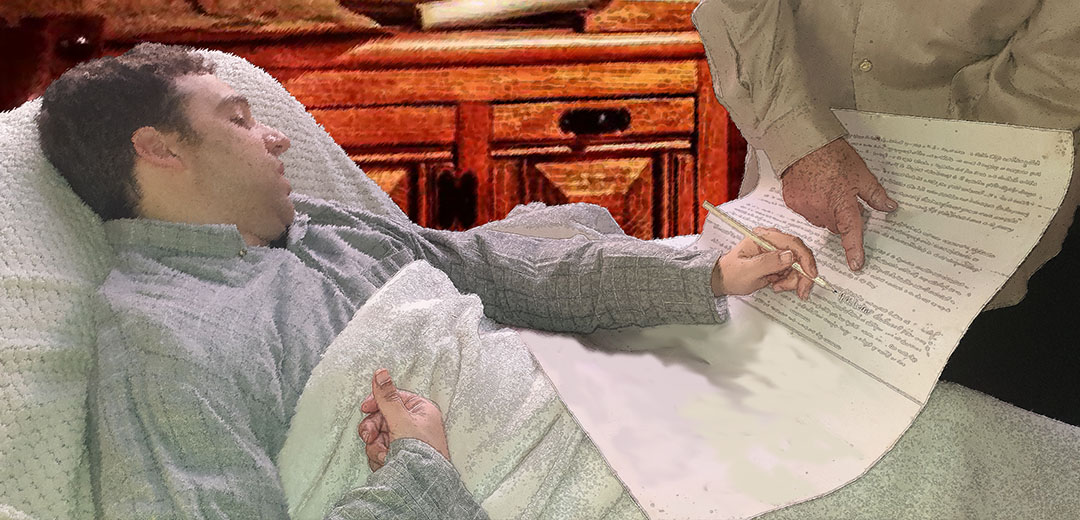
Hobson’s abysmal signature, assuredly, rendered the document worthless and a reject, as, if it had of been sent to either Australia or Britain, the poor signature could have accomplished little else but convince Hobson’s superiors that he was too ill to fulfil the most basic physical demands of office. It’s very doubtful that Hobson would have agreed to let the document be sent anywhere, other than to the nearest waste paper basket.

Glitch number 6. An unsupervised Freeman can't bring himself to "throw away" the sheet he's put so much hard work into creating. He therefore decides to send it to Reverend Robert Maunsell.
It seems very likely that the discarded document was left by Secretary Freeman near the portage* in Waitemata area and later came into the possession of Captain Gordon Brown. The captain was transporting much printed matter to Reverend Robert Maunsell, located at Waikato Heads, and passed through the Waitemata en-route to Maunsell’s station by mid-March 1840.
Either by overland courier, sent by Freeman or Captain Gordon Brown’s boat, Maunsell received the ruined English language memorial document well before the 11th of April 1840.
Inasmuch as Brown’s boat left the Bay of Islands to go to Thames (Waitemata Harbour) simultaneous to H.M.S. Herald leaving the Waitemata to return to the Bay of Islands, it seems that the two vessels were like “ships passing in the night” and never made contact. We know the document was left at Tamaki on the 4th of March with instructions by The Secretary (Freeman) that it be taken to Maunsell at Port Waikato.
Reverend Robert Maunsell himself tells us that Freeman sent the (reject and worthless) document, which he'd personally put a lot of work into creating, to Reverend Robert Maunsell at Waikato Heads mission station. Maunsell, in a letter to the Lay Secretary of 30th March 1840 made mention that "the Secretary" (Freeman) had sent the document to him. (See R Maunsell to Lay Secretary, 30 March 1840, in ATL-Micro-MS-Coll-04-33 (CMS Archives CN/M v. 12 pp 308-309).
*Footnote: The portage at Tamaki in Auckland was a thin strip of land dividing the East Coast (Pacific Ocean) from the West Coast (Tasman Sea). At this porterage boats, including small cargo vessels, were lugged, hauled or carried (porter is French for to carry) to the waters of the opposite coastal estuaries. The region of Portage Road, Auckland, is where this activity occurred.
If Captain Gordon Brown was sailing, via Waitemata, all the way to Reverend Maunsell, then he was obliged to have his boat hauled over the porterage, just like William Cornwallis Symonds did with his vessels about three weeks after Brown.
Of the 4th of March 1840 Treaty assembly meeting convened at Tamaki, Felton Mathew wrote to his wife:
'Last evening we received a communication from Mr. Williams that the natives had assembled. Accordingly, at 7 this morning, Cooper, myself and Captn Nias sailed down to the place of rendezvous where the ceremony of signing the treaty (as it is called) was soon performed and we have now just returned on board at 3 p.m.'
Captain Nias makes an account of this in his report, mentioning ‘Messrs. Williams and Fairburne’ organising a meeting and his attending it with Felton Mathew and George Cooper. Freeman’s handwriting appears on this Maori treaty signed on the 4th of March attesting to the fact that he was in attendance on the day, as there was no need for him to remain on board the H.M.S. Herald. Hobson was being medically attended to by Dr. Alexander Lane, M.D. & ship’s Surgeon.
Upon the return of stricken Hobson to the Bay of Islands, Willoughby Shortland, Acting Lieutenant Governor, organised a treaty-signing programme in earnest and was choosing experienced emissaries to go to particular Christian missions, along assigned routes, in behalf of the government.
The appointees were to work in with C.M.S or Wesleyan missionaries and gain their cooperation as fluent interpreters in the local tongue or dialect, at treaty meetings before the district chiefs. For this purpose, a series of treaty documents, all in the Maori language, had been prepared throughout February and most of these had been pre-signed by Hobson prior to his stroke.
James Stuart Freeman, who suffered from the disadvantage of being a non-Maori speaker, had painstakingly written up the majority of these large and beautifully executed documents.
Copying the Maori language correctly must have required tremendous concentration and it’s very likely that Freeman worked from a master copy created by Reverend Henry Williams. That self-same master document is probably the unsigned treaty, presently in the collection of the Catholic Diocese in St. Mary’s Bay, Auckland.
There is no record of how many treaty documents were made, but 7 large handwritten copies and 1 printed copy became the repositories of about 500 chiefly signatures from around the country. Freeman’s orphan, English copy, which mistakenly found its way to Port Waikato, was used there in no other capacity but to accommodate the overflow of signatures that would not fit onto the Printed Maori sheet presented by Maunsell on the day.
The instructions to each government appointee were clear. Treaty presentations to the chiefs were to be solely in the Maori language, using only the official text.
Sir James Henare, the last surviving member of the Council of the Chiefs of Ngapuhi of the Treaty of Waitangi recounted, in 1987, oral history about the Waitangi proceeding’s and later hui discussion:
‘Captain Hobson arrived on the 5th at the Treaty grounds and read the clauses of the Treaty or the articles of the Treaty and suggested to the chiefs that they could have ample time, a week, to consider the Treaty and it was the Maori version that was given to them to consider’ (see Hobson...Governor of New Zealand 1840-1842, by Paul Moon, pp 104-105).
This was amplified again, when Williams wrote:
'We gave them but one version, explaining clause by clause, showing the advantages to them of being taken under the fostering care of the British Government…’
‘The instruction of Captain Hobson was, “not to allow anyone to sign the treaty till he fully understood it;” to which instruction I did most strictly attend. I explained the treaty clause by clause at the signing of the same, and again to all the natives in this part of the island previously to the destruction of Kororareka, on March 11, 1845; I maintained the faith of the treaty and the integrity of the British Government, and that the word of Her Majesty was sacred, and could not be violated. That the natives to whom I explained the treaty understood the nature of the same, there can be no doubt; ...” (Volume II of “The Life of HENRY WILLIAMS, Archdeacon of Waimate,” by Hugh Carleton, published 1877 by Wilson & Horton, Auckland).
Let it be re-emphasised that every treaty copy issued by the government for presentation to the chiefs and earmarked to receive their signatures was written in, and was to be presented in, the Maori language. There were no exceptions to this rule.
At early assemblies where European settlers were present, Hobson read the Final English Draft (the mother document in English from which Te Tiriti o Waitangi was translated). Alternatively, Maori were to receive and consider only the version transmitted in their native tongue. This was in keeping with the instructions expressed in Lord Normanby’s Colonial Office, guideline brief, given to Hobson before he left England (over 4200-words in length):
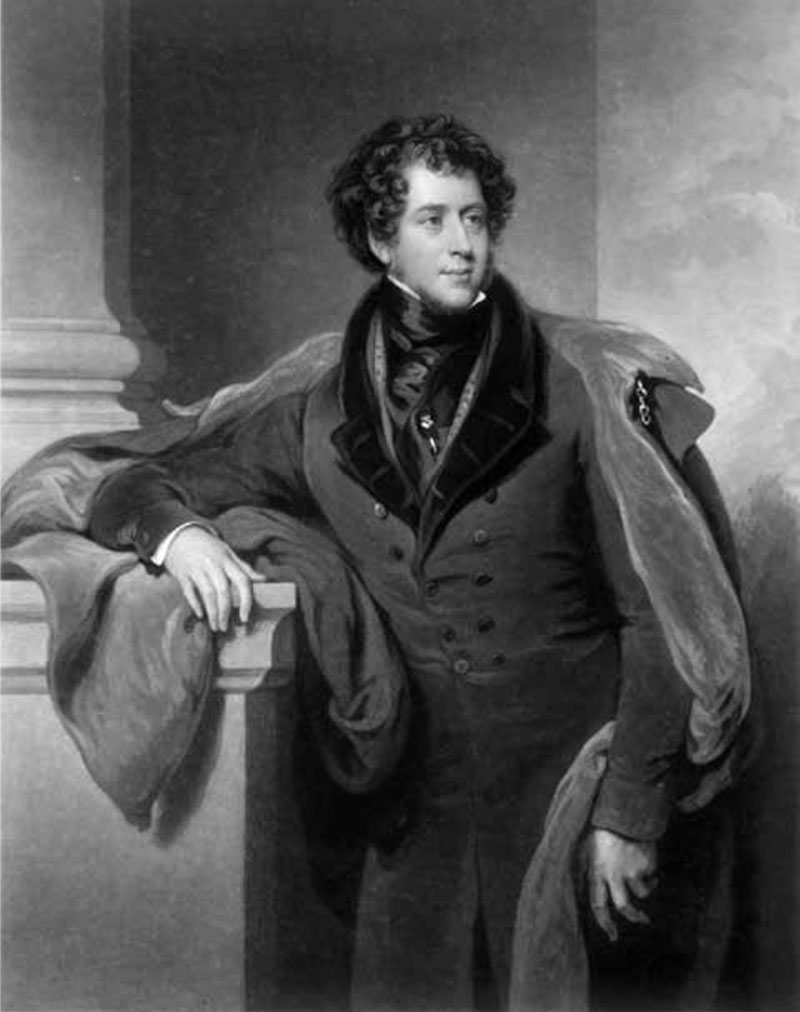
‘All dealings with the natives for their lands must be conducted on the same principles of sincerity, justice and good faith as must govern your transactions with them for the recognition of Her Majesty’s sovereignty in the Islands. Nor is that all: they must not be permitted to enter into any contracts in which they might be ignorant and unintentional authors of injuries to themselves*. You will not, for example, purchase from them any territory the retention of which by them would be essential or highly conducive to their own comfort, safety, or subsistence. The acquisition of land by the Crown for the future settlement of British subjects must be confined to such districts as the natives can alienate without distress or serious inconvenience to themselves. To secure the observance of this - will be one of the first duties of their Official Protector’ (See Lord Normanby’s 1839 Brief to William Hobson, The Treaty of Waitangi, by T.L. Buick, pp. 70-79). Underlining added.
*Footnote: Under this strict criterion only the Maori language treaty wording was ever earmarked for presentation to, and consideration by, the chiefs. Normanby’s Brief is explicit throughout that the whole venture is to be conducted at a high level of integrity and clearly understood negotiation.
Lord Normanby’s brief to Hobson was written by James Stephens, Permanent Under-Secretary of the Colonial Office (London) and son of a prominent abolitionist. The brief was essentially written by the anti-slave movement of Britain, initiated by William Wilberforce (1759-1833).
The Mission of William Cornwallis Symonds.
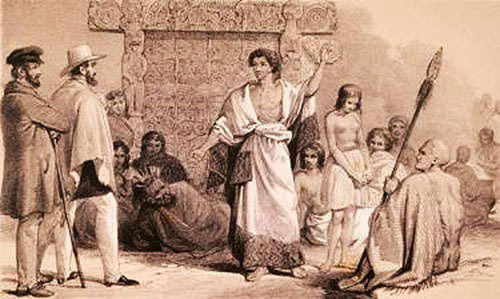
One of the only known depictions of Deputy Surveyor General, William Cornwallis Symonds, who tragically died at a young age by drowning in November 1841.
On the 13th of March, Shortland sent a newly made, signed Maori copy, penned by James Stuart Freeman and bearing Shortland’s signature, to Captain William Cornwallis Symonds, formerly an officer in the British Army and son of Sir William Symonds, Surveyor of the British Navy. Captain W.C. Symonds was Deputy-Surveyor of New Zealand and an accomplished linguist in the Maori language, with a vocabulary of 3000 words.
His assignment was to collect signatures at Awhiti, Manukau, assisted by Church Missionary Society catechist, Mr. James Hamlin, considered, by many Maori, to have the best accent and ability to enunciate in the Maori tongue of any speaker to be found amongst the European missionaries. Captain Symonds was to conduct treaty meetings with the chiefs, first at the southern shores of the Manukau Harbour, then, with the assistance of Reverend Robert Maunsell, at the Waikato Heads mission. From there Captain Symonds was to undertake a journey further south to the mission station of Wesleyan missionary, Reverend John Whiteley at Kawhia to collect signatures from chiefs ranging down the coast towards Taranaki.
Unfortunately, ardent opponents to the treaty, like Chief Rewa, influenced by the negativity of Bishop Pompallier, had already coloured the thinking of the chiefs at Manukau when Symonds arrived and none signed after the first hurriedly called meeting conducted by James Hamlin and William Symonds. Another meeting was held on the 20th of March where Paramount Chief Te Wherowhero was present, but the only signatures acquired came from three chiefs of the Ngati Whatua tribe. After two futile meetings and only meager success
Glitch number 7: William Cornwallis stays at Manukau an extra week in order to convene another treaty assembly ... He doesn't get to to Maunsell's assembly with the treaty sheet until 3-days too late.
William Symonds was obliged to abandon any further attempts at negotiation, for the moment, and make his way, belatedly, to Reverend Robert Maunsell at Waikato Heads. Symonds left Manukau on April 3rd, hauling his boats across the portage, which divides the Manukau from the waters of the Waikato. He then proceeded down the Awaroa River to the Church Mission Station at Waikato Heads, unfortunately arriving there several days too late for Reverend Robert Maunsell’s treaty meeting (see The Treaty of Waitangi, by T.L. Buick, pp 188-189).
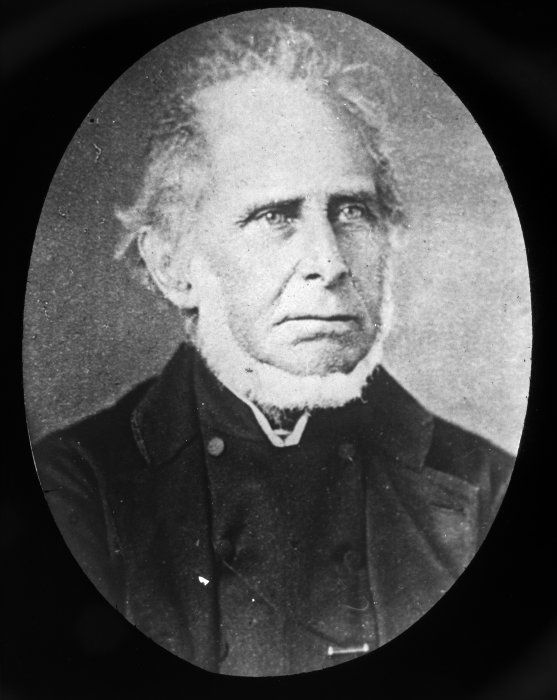
Reverend Robert Maunsell in old age. He was a lettered scholar and considered to be amongst the foremost missionary speakers of the Maori language in New Zealand.

The mission station of Reverend Maunsell at Port Waikato (Waikato Heads) where he held a treaty assembly before 1500 Maori on the 11th of April 1840.
Reverend Maunsell had been obliged to take advantage of an already scheduled business meeting (hui) of the natives in his district to address their assembly concerning the treaty, but without his official, government issued, Maori language treaty sheet
This meeting was held on April 11th 1840, before a huge Maori assembly (1500 people). Reverend Maunsell was very successful in his endeavours, but within the space of a few days it dawned on the signatories that they had not received blankets, like other chiefs of the north, as tokens of friendship and thanks (koha). Some chiefs were insulted by this oversight and wanted to ‘tear the treaty up’ as a result of the perceived breach in protocol. Reference to this “hui” is mentioned in Te Manihera...The Life and Times of the Pioneer Missionary Robert Maunsell, by Helen Garrett, 1991, pg. 90, wherein it says:
‘Amongst the missionaries, four were appointed to collect signatures. One of the four was Maunsell*, who was sent a copy of the Treaty* and was responsible for getting signatures of the Waikato chiefs. He took advantage of a business meeting of the natives in his district to produce the Treaty’.
*Footnote: It’s important to remember that Maunsell was only ever sent one official treaty document by the government (and that it was a Maori language version), dispatched with William C. Symonds on the 13th of March 1840 and originating from Willoughby Shortland, Acting Lieutenant-Governor. It didn't’t arrive in time.
Thankfully, before the situation with the slighted chiefs at Waikato Heads got too far out of hand for Reverend Maunsell, Captain W.C. Symonds arrived at the mission. He’d brought Maunsell’s official treaty document too late for it to be of any use. Symonds had a few blankets with him and these were distributed, with a promise that more were arriving. The formerly insulted chiefs were appeased at the gesture and goodwill returned. Maunsell had been awaiting the arrival of Symonds, ‘with no small anxiety’ (see The Treaty of Waitangi by T.L. Buick, pp 188-189).
Glitch number 8: Because Maunsell's government-issued treaty sheet didn't arrive in time, he was forced to read the authorised text from a Printed Maori sheet, which the first 5 chiefs coming forward signed ... then ran out of room.
Maunsell, in lieu of having received the official treaty document, had innovated to take advantage of the hui business meeting on the 11th of April, at which chiefs from far and wide were assembled. For his presentation on the day he had a Church Mission Society Printed Maori version of the Treaty of Waitangi, undoubtedly sent down by Colenso from Paihia, via Captain Brown on the 4th of March 1840. He also had a beautifully hand written, but unauthorised or defective, English copy.
This English copy was one of the ‘Formal Royal Style’ versions for overseas despatch, penned by James Stuart Freeman, using rejected, obsolete text from Busby’s rough notes of the 3rd of February 1840 and one of two choices of early Preambles.
True to his instructions from Hobson, Maunsell would have conducted his entire presentation in the Maori language, using only the Maori text. Nevertheless, the big, impressive looking piece of paper in English had a large clear space at the bottom, which could serve the purpose of accommodating additional signatures when there was no further room left on the Church Mission Society (Maori language) printed copy.
Like at all other centres around New Zealand, it was obligatory that the standard Maori text was required to be presented to the chiefs and 1500 of their tribes-people at Waikato Heads.
The first chiefs coming forward signed the C.M.S. Mission printed sheet, but quickly ran out of room. Reverend Maunsell’s signature can be seen on the upper right-hand side of the handwritten section, where it says, ‘signed in my presence, R. Maunsell’. All handwriting on this sheet is that of Reverend Robert Maunsell.
Either James Stuart Freeman sent this Maori language Printed copy to Maunsell on the 4th of March 1840 (along with his "ruined" Formal Royal Style English document he'd created) or Captain Gordon Brown brought this copy to Maunsell in mid or late March. Colenso issued several hundred printed items to Captain Brown on the 4th of March at Paihia, which were destined for Maunsell at Port Waikato*.
*Footnote: According to the Day & Waste book of C.M.S. printer, William Colenso, on the 4th of March 1840 he “issued” a large batch of materials for Reverend Robert Maunsell of the Waikato Heads mission. Colenso’s record states that he printed 500 Prayer [books], 300 Primers, 200 Kupu Ui and 3qu (3 sheets for covers). These were ‘issued’ to Gordon Brown to be taken to Maunsell on Brown’s boat, going by way of Thames. Colenso’s note stated: ‘Issued to R. Maunsell, for Waikato and Manukau’ (see Colenso’s Day and Waste Book, 1840, Auckland Institute and Museum Library).
Here is the C.M.S printed Treaty of Waitangi text copy, used by Reverend Robert Maunsell and his assistant Benjamin Yate Ashwell on April 11th 1840:
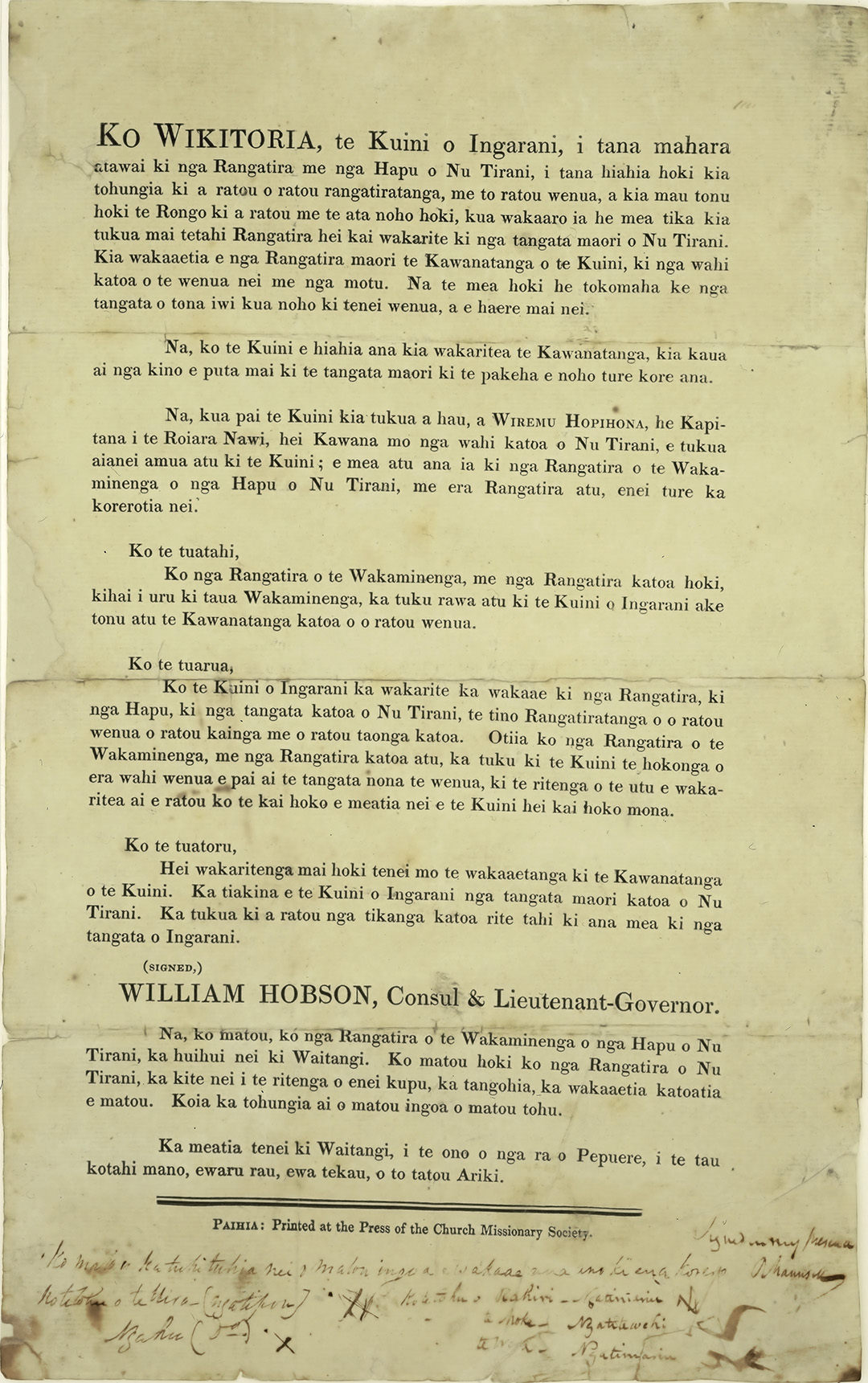
Like at all other centres around New Zealand, this standard Maori text is what was presented to the chiefs and 1500 of their tribes-people at Waikato Heads. The first chiefs coming forward signed this sheet, but quickly ran out of room. Reverend Maunsell's signature can be seen on the upper right-hand side of the handwritten section, where it says, 'signed in my presence, R. Maunsell'.
All handwriting on this sheet is that of Reverend Robert Maunsell. Captain Gordon Brown brought this copy to Maunsell in mid or late March. Colenso issued several hundred printed items to Captain Brown on the 4th of March at Paihia, which were destined for Maunsell at Port Waikato.
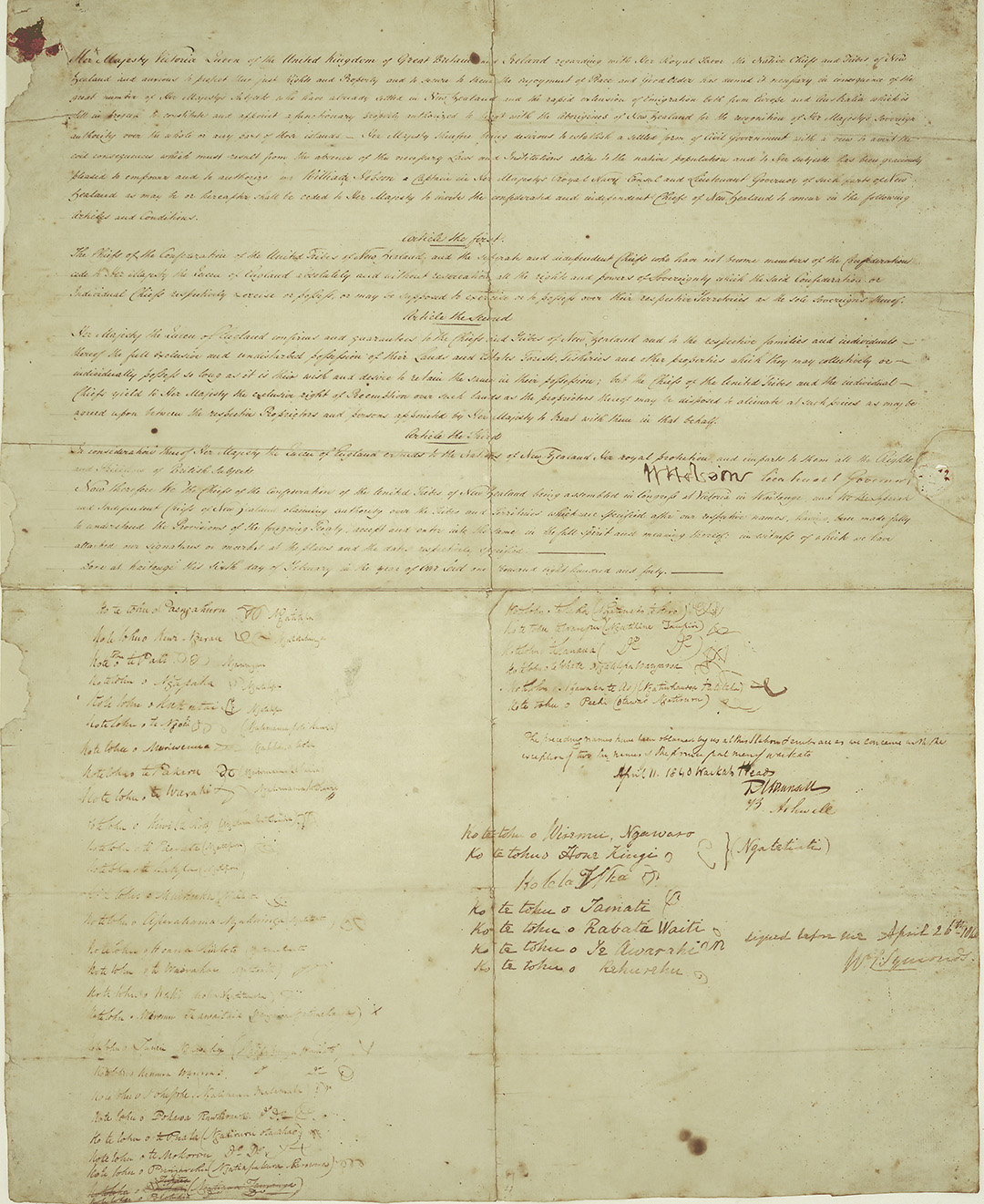
Glitch number 9: Unfortunately, Reverend Robert Maunsell allowed 32 "overflow" signatures to be placed on Freeman's discarded Formal Royal Style sheet, instead of using another blank piece of paper.
Unlike the printed Maori copy that Maunsell based his presentation of the 11th of April 1840 on, this big, unauthorised piece of paper, at least, had sufficient room at the bottom to receive the overflow of signatures that wouldn't’t fit on the printed Maori sheet. On the day, after the first five chiefs had signed the printed Maori copy, the next thirty-two signatures overflowed onto this one.
Maunsell’s naive and innocent use of this piece of discarded paper as a repository for overflow signatures was, 135-years later, exploited by activists and social-engineers to destroy the treaty.
One can easily see that Maunsell conducted his meeting correctly, but that a miscellaneous piece of paper was pressed into service when the official-text document had no further room to accommodate signatures.
The signatures of the chiefs were volunteered in good faith, in response to what they had heard and understood, which was Te Tiriti O Waitangi text in Maori.
The true, accompanying Maori document, containing the pertinent contract wording presented by Maunsell, was on the table and was in the process of being signed. It would have continued to receive all the signatures of all the chiefs had there been space available. When there was no more room to accommodate additional signatures, the overflow signatures spilled over onto the second sheet, the content of which was irrelevant, inasmuch as it was in a foreign tongue and had never been presented. It was just a piece of paper, pressed into service and acting as a physical extension to the Printed Maori Tiriti O Waitangi sheet.
Hobson had stated that there was only one de facto treaty and that it was a text in the Maori language.
Most assuredly, Robert Maunsell stood before the 1500 Maori, gathered in to Port Waikato on the 11th of April 1840, and read them the correct, singularly Maori text, lifted directly from the official C.M.S. Mission printed sheet in his possession, which he later signed. The assembled Maori at Waikato Heads heard exactly what every other assembly heard, which was the standard Maori text for consideration and discussion. The same holds true for all three Treaty assemblies conducted at Manukau by Symonds, the last one of which involved the usage of Maunsell’s “make-do” treaty documents.

THIS IS THE ONLY TREATY DOCUMENT EVER ISSUED BY THE GOVERNMENT FOR USE IN THE TREATY PRESENTATION AND SIGNING ASSEMBLIES AT MANUKAU, PORT WAIKATO AND KAWHIA. NOTE: IT IS IN THE MAORI LANGUAGE!
The foregoing is the ONLY official treaty document (handwritten by James Stuart Freeman in Maori) ever issued by the colonial government for use in the signing ceremonies at Manukau, Waikato Heads and Kawhia.
These regions and districts, nominated for treaty discussion and signing gatherings before the chiefs, constituted the mission of Captain William Cornwallis Symonds, Government appointee for treaty negotiations and Deputy-Surveyor of New Zealand. W.C. Symonds’ assignment, issued by Acting Lieutenant Governor, Willoughby Shortland, was to go first to Manukau and receive signatures from the chiefs there with the assistance of Missionary James Hamlin of the C.M.S. Station.
He was next to go to Waikato Heads and conduct a treaty meeting, with the assistance of Reverend Robert Maunsell and Benjamin Yate Ashwell. After completion of work at and around the Waikato Heads district, Symonds was to carry this official document, bearing all signatures gathered en route, to Reverend John Whiteley and his assistant, James Wallis and conduct a series of meetings there, as well as, further south in Taranaki.
Maunsell wrote to Hobson: ‘and I have already forwarded on to Messrs Wallis and Whiteley the document left with me by Captain Symonds in order that they may obtain as many more names as they deem expedient’ (see Robert Maunsell LL.D. A New Zealand Pioneer, His life and Times, by Henry E.R.L Wily, 1938, pp 68-69).
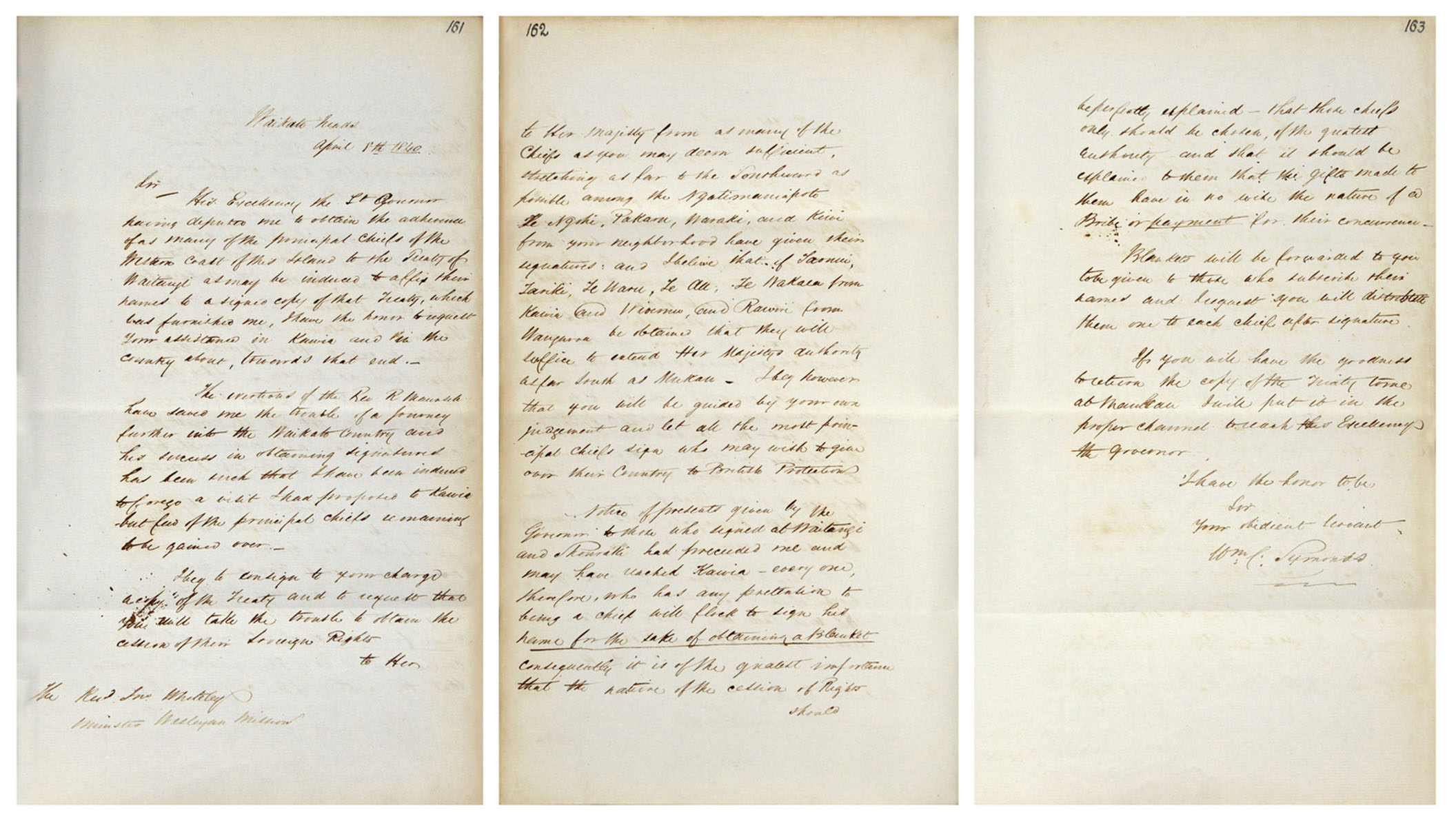 The letter of W C Symonds to Reverend John Whiteley. At all three meetings at Manukau the chiefs heard each presentation in their native tongue.
The letter of W C Symonds to Reverend John Whiteley. At all three meetings at Manukau the chiefs heard each presentation in their native tongue.
Maunsell was known to be amongst the most accomplished Maori speakers, to be found in the ranks of the missionaries in New Zealand. At the time of this meeting at Port Waikato he was engaged in translating the Old Testament of the Bible into Maori. Earlier, in order to learn the language, he would sit in discussion circles with Maori and have long conversations on general topics.
After becoming very fluent he made an offer: If anyone in the circle heard him use a word in error or out of context, then they would receive a wad of tobacco, once they’d proven he was, in fact, incorrect in his use or understanding of a word. Maunsell, apparently, went through a lot of tobacco but, in the end, graduated to becoming a formidable linguist in Maori.
Historian Ruth Ross wrote in 1972:
‘James Edward FitzGerald remarked in a debate on the Treaty of Waitangi in the House of Representatives in 1865: ‘if this document was signed in the Maori tongue, whatever the English translation might be had nothing to do with the question.’ He went on to point out: ‘Governor Hobson might have wished the Maoris to sign one thing, and they might have signed something totally different. Were they bound by what they signed or by what Captain Hobson meant them to sign?’
SO WHY IS IT SO IMPORTANT FOR THE TREATY MEANING TO BE BASED SOLELY ON THE MAORI TEXT & TRUE FINAL ENGLISH DRAFT?
It’s actually quite simple: ... Because that's the finalised, definitive and tight text that defined the agreement, leading to the formation of a British colony under Queen Victoria.

Matiu Rata, Minister of Maori Affairs, who was instrumental in perpetrating an immense con, leading to the reinvention of the Treaty of Waitangi and waving-aside the inalienable rights of the majority of New Zealanders.
By 1975 the Minister of Maori Affairs, Matiu Rata, and the Maori Council desperately wished to radically change the entire meaning of the Treaty of Waitangi and needed a vehicle whereby they could pull off this ruse.
At this time, there was only one internationally recognised wording for the Treaty of Waitangi, solely in the Maori language. However, that wording was very tight, well-understood and not open to reinterpretation.
Because the Maori wording couldn't be tampered with, Matiu Rata and the Maori Council had to find an Achilles’ Heel glitch and decided to focus their attention on the obsolete, discarded English rough-draft wording James Stuart Freeman had used when writing his several Formal Royal Style memorial documents, earmarked for oversea despatch to foreign dignitaries during 1840.
To get the ball rolling in distorting and reinventing the meaning of the Treaty/ Tiriti Matiu Rata and his cohorts needed to get “Official Recognition”, of a Formal Royal Style English version text enshrined into New Zealand law. He therefore proposed a Bill to go before Parliament (Treaty of Waitangi Act 1975) wherein “an English version of the treaty could be adopted into legislation to sit alongside Te Tiriti o Waitangi and be coequal to it”.
With the true, Final English Draft, written on the 4th of February 1840, having been lost “sometime in February 1840” , the New Zealand Government, in 1869, officially commissioned The Native Department to supply a back-translation of the Maori Tiriti.
This the Native Department did, rendering a perfect back-translation.
If Matiu Rata and the Maori Council truly wished to have an English text that perfectly mirrored the meaning and intent of Te Tiriti o Waitangi, then they already had an Official government commissioned and issued one, in legislation for 106-years, to refer to.
Glitch number 10: Although the two sheets used for Maunsell's "make-do" treaty document were supposed to remain eternally wax-glued and stick-pinned together they were, at some point separated.
Someone, out of ignorance or with a sinister motive in mind, separated the two pieces of paper that constituted Mausell's singular treaty document and they're now counted as documents stemming from two separate assemblies, although both signed by Maunsell and containing the names of Port Waikato chiefs. Forensic evidence proves conclusively that the two sheets were formerly joined, but were forcibly separated.
Added to all the above evidence, in 1989 the original Final English Draft was found in private papers of the Littlewood family deceased estate, Pukekohe, New Zealand. It's text perfectly mirrors the meaning and intent of the 1869 back-translation, as do all other known back-translations. The pedigree of the Littlewood document has a clear paper-trail traceable back to Lieut-Governor, William Hobson (1840).
The Littlewood Treaty, which was Busby’s final draft of the 4th of February 1840 |
The Maori text translated by Reverend Henry Williams & Edward M. Williams 4-5/2/1840 |
Translation from the Original Maori by, Mr. T.E. Young, Native Department (1869) |
However, Matiu Rata and the Maori Council definitely didn't want the 1869 official back-translation sitting alongside, and coequal to, Te Tiriti. It was absolutely essential to their scheme that James Stuart Freeman’s Formal Royal Style document, which received signatures on it at Maunsell’s 11th of April, 1840 treaty assembly at Port Waikato (Waikato Heads), be adopted into legislation and accorded the status of the Official English wording of the Treaty of Waitangi.
So, why did Matiu Rata and his cohorts want recognition of only this one?
It was because the entire text content was based upon very exploitable, discarded rough draft notes, written between the 1st and 3rd of February 1840 and not the Final English Draft (the mother document from which Te Tiriti was translated) written on the 4th of February 1840.
In other words, the text and content is quite different to both Te Tiriti o Waitangi and the Final English Draft.
So, what’s a “Draft”?

Say, at school on Friday your teacher asks you to write an essay over the weekend titled, “What I did on my holiday”, to be handed in on Monday morning.
Your first efforts on Friday night are pretty lame and you lack inspiration, so have another go through Saturday. There’s a bit of an improvement, but it’ll take a lot more concentration. Ideas are at least starting to come together and your rough notes are sounding better. Several more drafts are written on Sunday and it’s slowly developing into something coherent and looking good. Now you go over it and write-up the pristine, spell checked last effort … and this is what you hand in on Monday.
Under this scenario, your earlier, discarded notes are not what you want the teacher to see & mark … those several “work-in-progress” attempts, with their omissions, additions, etc., are only your “rough draft notes” and not the Final Draft.
It was no different for Captain William Hobson and his helpers between February 1st and the 4th 1840, experimenting with text and concepts as they attempted to write the Preamble, Articles and Affirmation sections of the Treaty of Waitangi … except that they had to be very precise and measure their words with utmost care.

This is a sample of the Rough Draft English treaty notes that were written up to February 3rd 1840, then discarded when the Final English Draft was written on the 4th of February. Freeman's Formal Royal Style memorial documents are made up of selected bits & pieces from ONLY these obsolete notes and NEVER from the Final English Draft from which Te Tiriti o Waitangi was translated. Note the crossed out parts and the use of a second column on the left for adding in possible replacement text. All of the rough draft notes look like this and no Final English Draft can be found amongst them.
To see all of the discarded, obsolete rough draft notes they produced … leading up to the Final English draft see: https://www.celticnz.co.nz/TreatyDocumentary/TreatyDocumentaryPart1.html (halfway down the page).
So, what was the outcome of Matiu Rata and the Maori Council pulling off this ruse?
Glitch number 11: Lack-lustre historians remain incapable of piecing together the document paper-trail that clearly identifies the true sequence of treaty-related events.
Because NZ politicians were either ignorant or complicit and our so-called treaty experts moral-cowards in not speaking out, Matiu Rata achieved formal recognition for one of James Stuart Freeman’s Formal Royal Style "COMPOSITE" treaty versions being elevated to the status of the Official English text of the Treaty of Waitangi (something it had never been for 135-years).
Thereafter, the world was his oyster. He could now really muddy-the-waters and begin a campaign of helter-skelter, to destroy the meaning of the treaty.
A very shrewd Matiu Rata and his cohorts then began to point out how very different the wording was to the Maori language text and added: “This must be the British understanding of what the treaty says”.

Having brought in this utterly non authorised and illegitimate text, based upon rough draft notes, to be coequal in authority to the Maori language text, Rata was able to push the Maori Tiriti (the only true treaty wording) forever into the shadows and never consult it again. Instead, he and his entourage embarked on their campaign to completely reinvent the meaning of the treaty, based upon obsolete wording discarded by the drafters of the treaty before the 4th of February 1840. The Final English Draft (the mother document from which Te Tiriti o Waitangi was translated) was an altogether different text.
For a comprehensive review of the twisted, undocumented historical-arguments and dirty-tricks Rata and his cohorts used, see: https://www.celticnz.co.nz/TreatyDocumentary/TreatyDocumentaryPart1.html
Glitch number 12: New Zealand politicians and historians, the United Nations, self-enriching lawyers, etc., allowed Matiu Rata and Maori activists get away with this criminal act based upon false-history.
In a fair and just New Zealand, where no-one was vying for advantage over anyone else, the circumstances of what happened at Port Waikato on the 11th of April, 1840 or at Manukau on the 26th of April 1840, wouldn’t warrant serious comment in any legal sense. It’s crystal clear what happened and the minor glitch of an unauthorised English language document being pressed into service to accommodate overflow signatures cannot possibly render the Maori Tiriti O Waitangi text null and void as we’re led to believe.
The logic that the grievance industry advocates bludgeon us into accepting without question is that the signatures of over 500 chiefs, affixed to Maori language treaty documents, were eclipsed and made worthless when Maunsell innovated, without government sanction, to have a “make-do” treaty document available for his meeting... despite the fact that he presented the only authorised Maori Tiriti o Waitangi text to the chiefs, who then came forward to sign, solely on the basis of what they had just heard.
Somehow, according to the logic we’re supposed to blindly accept, all European settler rights were immediately extinguished by Maunsell’s faux pas. Moreover the entire mission of Hobson, unbeknown to him as he recuperated miles away at the Bay of Islands, suddenly became an abject failure.
Instead of legally dismissing this minor procedural glitch with the shrug that it deserves, it’s allowed to be a bastion and rallying point for a pack of voracious hyenas, intent upon gorging themselves insatiably on a succulent carcass called New Zealand.
William Cornwallis Symonds, continued:
The official document, brought by W.C. Symonds, which had arrived too late for Reverend Maunsell’s meeting, was forwarded on, by Maunsell, to Reverend John Whiteley, further to the south at Kawhia. To see this official document that Maunsell was, technically, supposed to use, we need only view Reverend Whiteley’s document to which the last signature was added on September 3rd 1840.
Captain W.C. Symonds started heading south in an attempt to add more signatures to Maunsell’s make-do treaty documents (composed of a C.M.S. Mission printed Maori treaty sheet and the other defective English sheet with sufficient space available to accommodate signatures).
He had missed attending Maunsell’s very successful meeting at Waikato Heads, for which he’d brought the official document. That document had been left with Maunsell for direct despatch, by messenger, to Reverend Whiteley at the Kawhia Mission Station. Symonds, it would seem, was going to take a circuitous route to acquire yet more signatures in the district, then meet up with Reverend Whiteley later and take all signatures acquired, on all 3 documents, back to Government House in Russell.
For his own signature gathering incentive, before meeting up with Reverend Whiteley at Kawhia, Symonds would, for the first time, use Maunsell’s make-do documents, bearing the signatures that Maunsell and Ashwell had acquired at Waikato Heads on April 11th 1840.
Shortly after leaving Reverend Maunsell, however, Symonds took time to look closely at the signatures that Maunsell had acquired, undoubtedly in an effort to plan his itinerary and movements. Upon examination he could see from the 5 signatures on the Maori copy and the 32 signatures overflowing onto the English sheet, that all the primary chiefs, except a few from Kawhia area, had already signed the treaty.
Reverend John Whiteley and his assistant, James Wallis, could acquire these few missing signatures, without his participation. Symonds decided, therefore, to venture no further south, but to attempt, once more, to convince the chiefs at Manukau to add their signatures (some of which had been promised) and especially Paramount Chief, Te Wherowhero.
William Symonds, consequently, sent a letter on to Reverend Whiteley, informing him that he was not now coming, and asking him to proceed in the signature gathering incentive without him. Maunsell had already dispatched the official treaty document southward to Reverend Whiteley by messenger, expecting that all documents and letters would come together when Symonds finally reached the mission station there at Kawhia.
Unbeknown to Maunsell, when he wrote his report to Hobson, Symonds would later decide to return for a third try at getting signatures at Manukau and not go south to Kawhia as expected. Three earlier acquired Ngati Whatua signatures, from the second meeting at Manukau, were on the official document, now in the possession of Reverend John Whiteley in Kawhia. Symonds, without access to that document, would, as stated, use Maunsell’s unofficial make-do documents, bearing the many signatures that Reverend Robert Maunsell and his assistant, Benjamin Yate Ashwell had acquired at Waikato Heads on the 11th of April.
This impressive list would, most assuredly, have some influence on the reluctant chiefs at Manukau. Maunsell, sent a letter with Symonds, addressed to Hobson, which said:
‘You will, I trust, receive with this [letter dispatched with Symonds] the document lately forwarded to me to have the signatures of the principal men in Waikato attached to it. I am happy to inform you that the signatures obtained comprise those of the leading men, except perhaps two. Those we hope soon to obtain, and I have already forwarded on to Messrs Wallis and Whiteley the document left with me by Captain Symonds [the one Maunsell was supposed to use...the official government issued document] in order that they may obtain as many more names as they deem expedient’.
On May 12th, 1840, Captain W.C. Symonds reported:
'On examination of the signatures obtained by Mr. Maunsell, I found that with the exception of very few, all the leading men of the country as far as Mokau had acknowledged the sovereignty of Her Majesty. The few belonged to the neighbourhood of Aotea and Kawhia, wherefore I determined proceeding myself no further, being well assured of the disposition on the part of the Wesleyan Mission to support the Government in every exertion in its power, and I sent a letter to the Rev. John Whiteley claiming his assistance in procuring the remaining names. I returned to Manukau on April 18, where I obtained the adherence of seven other chiefs to the Treaty. Te Whero-whero and several others have objected, though they manifest no ill-will to the Government (see Robert Maunsell LL.D. A New Zealand Pioneer, His life and Times, by Henry E.R.L Wily, 1938, pp 68-69).
So, it becomes very clear what had happened with the various documents:
(a) Reverend Maunsell had not been able to use his official document, sent to him from Government House in the Bay of Islands and signed by acting Lieutenant Governor, Willoughby Shortland, as it had arrived 3 days too late. He had used, instead, materials on hand to conduct his meeting on the 11th before 1500 Maori, conveniently gathered in for their hui business meeting. His document for the hui meeting was an authorised Maori text, printed by the Church Mission Society. Two hundred of these authorised Maori treaty text documents had been produced by Paihia Mission printer, William Colenso on February 17th 1840.
(b) At the April 11th meeting another unauthorised piece of paper had been used in no other capacity but to receive the overflow of signatures that would not fit onto the printed Maori text document. Reverend Maunsell wrote a letter to Hobson, describing what had transpired locally and gave it to Captain William Symonds, who, supposedly, was heading southward, by a circuitous route, to eventually join up with Reverend John Whiteley at the Kawhia Mission.
(c) Captain Symonds later changed his mind en route, after looking over Maunsell’s list of signatures and deciding that his efforts should be focused on Manukau, where he’d had only moderate success, despite two meetings with the chiefs there.
(d) Symonds, unbeknown to Maunsell, returned to Manukau, this time with a different document (Maunsell’s signed, Maori printed text from the C.M.S Press and the orphan English treaty document, (used only to accommodate the signatures).
During his third attempt at Manukau, on the 26th of April, Symonds managed to get an additional seven signatures, bringing his tally in the Manukau area to ten signatures in three meetings. Captain Symonds then took or sent all of the signatures, affixed to the two pieces of paper used by Maunsell, Ashwell, and himself, to Hobson.
The official document, which was the only one envisioned by acting Lieutenant Governor, Willoughby Shortland, to be signed in Manukau, Waikato Heads and Kawhia, came back, from Reverend John Whiteley to the Bay of Islands after September 1840.
We know full well from the May 12th report of William Cornwallis Symonds that he was talking about the printed Maori document being used for the presentation at Waikato Heads, as well as his 3rd attempt at Manukau, with the English copy being used solely to accommodate the overflow signatures obtained. Symonds writes:
‘I have the honour to submit to you for the information of His Excellency, the Lieutenant Governor, a Report of my proceedings in the Manukau and Waikato districts in my late mission to obtain the adherence of the Principal Chiefs on the West Coast of this Island to the Waitangi Treaty and herewith - transmit to you a Copy of the Treaty signed by upwards of Forty of the more influential Chiefs of that part of the Country’. Underlining added.
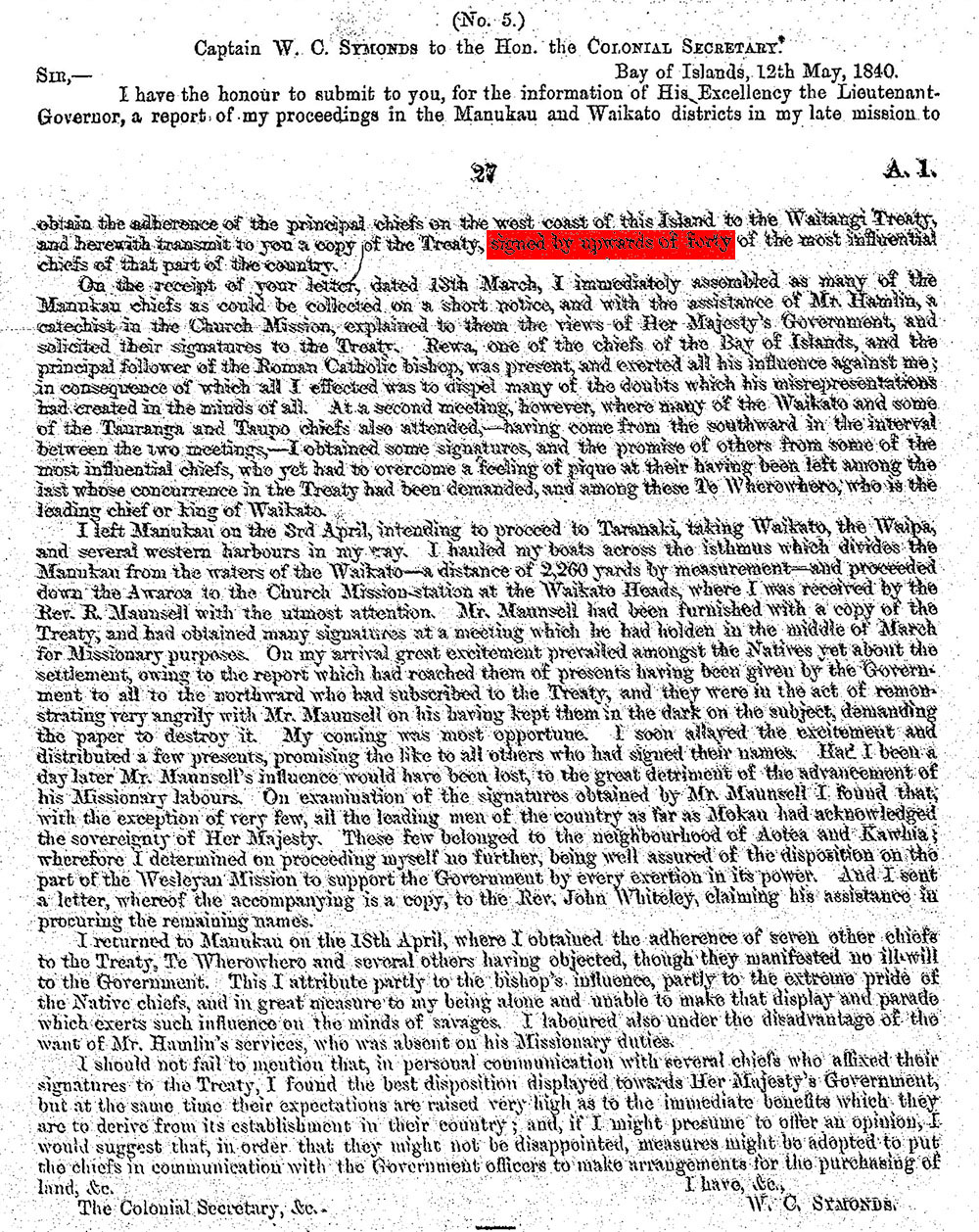
Symonds is stating that the signed treaty he is submitting contains ‘over forty’ signatures. The actual tally is:
The orphan English copy has 32 signatures obtained by Maunsell on the 11th of April 1840 (at Waikato Heads) and another 7 signatures obtained by Symonds at Manukau (third attempt there) on the 26th of April 1840 = 39. The printed Maori copy, read to the assemblies at both gatherings, contains the very first of the 5 chiefly signatures obtained at Waikato Heads on April 11th by Reverend Maunsell, bringing the final total to 44.
If we then include the 3 Ngati-whatua signatures that William C. Symonds acquired in Manukau on the 20th of March 1840 (his 2nd meeting there), which were recorded upon the official government issued, Maori language document, pre-signed by Willoughby Shortland, then the full tally for the Manukau and Port Waikato districts is 47.
Historian Claudia Orange, admitted the following on her former website:
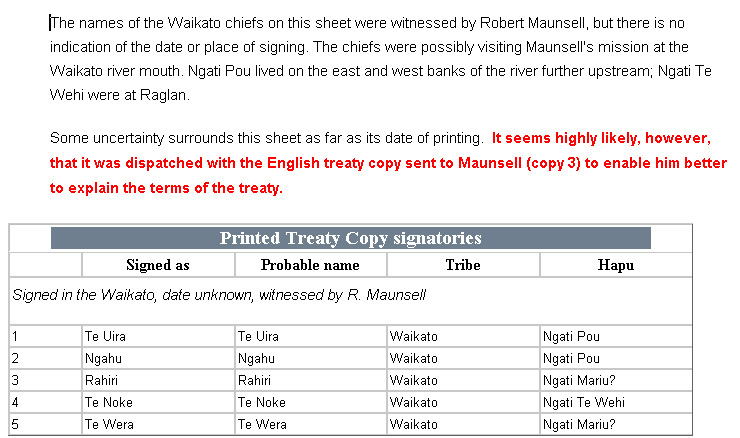
‘The names of the Waikato chiefs on this sheet [printed C.M.S treaty] were witnessed by Robert Maunsell, but there is no indication of the date or place of signing. The chiefs were possibly visiting Maunsell’s mission at the Waikato river mouth. Ngati Pou lived on the east and west banks of the river further upstream; Ngati Te Wehi were at Raglan. Some uncertainty surrounds this sheet as far as its date of printing [signing?]. It seems highly likely, however, that it was dispatched with the English treaty copy sent to Maunsell to enable him better to explain the terms of the treaty’. Underlining added.

These statements by Claudia Orange are unnecessarily vague, poorly researched and evasive. They are “Red Herring” statements designed to lead us off the path and get us to believe that Maunsell stood before 1500 Maori and presented only Freeman’s Formal Royal Style memorial document in English to Maori, when 99% of those present did not speak English or understand it sufficiently ... Preposterous!
By eternally cleaving to this sinister ploy of uncertainty, Claudia is like "Emperor Nero" ... who "fiddled while Rome burned". All she is doing is buying time for her grievance-industry handlers to wreak havoc with New Zealand's social & political structures. When I have confronted her on 3-occasions, face-to-face, concerning the evidence of Maunsell's "make-do" treaty documents (2 pieces of paper) her response has always been: 'We're looking into it, and you might be right, but we just don't know'!
Claudia Orange has now been "looking into it" for at least 18-years.
Social-historians, like Orange and her colleagues, working for the grievance-industry, have to continue to push the lie that the “Printed Maori” sheet was signed on a totally different, unknown and unrecorded occasion at Port Waikato. This ploy allows her to argue that Maunsell only had Freeman's Formal Royal Style English language copy and read that to the 1500 Maori at his treaty assembly. This further infers that the NZ government deliberately sent ONLY an English language version to Maunsell for use at Port Waikato ... and ignores the fact that Acting Lieutenant-Governor Shortland only ever sent a Maori language sheet with Deputy-Surveyor William Cornwallis Symonds ... which arrived 3-days too late.
However, more recent forensic evidence proves conclusively that the Formal Royal Style English language document and the Printed Maori sheets were wax-glued and stick pinned together to form one “make-do” treaty.
The forensic evidence proves there is no substance to the co-governance argument, or any of the of the treaty-reinvention rubbish we have been gruesomely tortured with since 1975.
See: https://youtu.be/dFFORRwtcUU
The only government issued document ‘sent’ to Maunsell was a handwritten Maori language one, authored by Freeman under Shortland’s direction and carried overland or via waterways by Symonds, commencing on the 13th of March 1840.
Reverend William Colenso, who had printed 200 Maori treaty sheets for distribution to signatory chiefs, on the 17th of February 1840. He sent a consignment of goods to Maunsell on March 4th 1840 with Captain Gordon Brown, who took his boat across the “Portage” near Tamaki on about the 6th-8th of March 1840 …. Fully 5-weeks before Maunsell’s 11th of April treaty assembly. Of the 200 Printed Maori language sheets, containing the only text Maori were allowed to hear, it would not be unreasonable to assume that Brown gave Maunsell a wad of perhaps 15-20 for local distribution.
There’s no way Maunsell would have made any form of presentation of Te Tiriti O Waitangi, as he was obliged to do, without having on hand Te Tiriti O Waitangi text!
William Symonds, who tried on three occasions to get signatures from the chiefs at Manukau, well understood the importance of unfaltering and strong oratory before the Maori assemblies. On two occasions he had the very adept assistant and much-respected orator, James Hamlin to help him. At the 3rd Manukau meeting James Hamlin was absent on the day, having traveled to another mission. Symonds later lamented:
‘I obtained the adherence of seven other chiefs to the Treaty. Te Wera-Wera and several others, however, objected.... This I attribute partly to the Bishop’s [Pompallier’s] influence, partly to the extreme pride of the Native chiefs, and in great measure to my being alone and unable to make that display and parade which exerts such influence on the minds of the savages’ (see W.C. Symonds’ letter to the Colonial Secretary, 12 May 1840. Great Britain Parliamentary Papers 1841 (311) XVII pp. 101-2).
Reverend Robert Maunsell, a lettered scholar and linguist, was personally engaged in translating the Old Testament of the Bible into the Maori language at the time he made his treaty presentation to 1500 Maori at Waikato Heads. Of Maunsell’s meeting, T.L. Buick writes:
‘The project had been received by the natives in the most friendly spirit, and signatures had been obtained with the utmost alacrity’ (see The Treaty of Waitangi, by T.L. Buick, pg. 189).
Some years later, in 1845, Rev. Maunsell wrote the following during a time of conflict (Hone Heke’s rebellion):
‘Whether that Treaty was a ‘fiction’ or not, this is no fiction, that the Government stands pledged to secure certain rights to the Aborigines, & that the Aborigines were fully informed of that promise. Whether that Treaty has been attended with injurious consequences or not I do not know. This I know, that if it had not been for those stipulations the Colony could not have been established without war with the Aborigines and other more serious evils than those which at present attend it. The people may not perhaps understand all the particulars of that treaty, but we, their teachers took particular care to explain to them, as far as was necessary to allay the suspicions & jealousy with which they contemplated the movements of Government’ (see R. Maunsell to Secretaries, 23 April 1845, in ATL-Micro-MS-Coll-04-35 (CMS Archives CN/M v. 15 p. 311).
Hobson wrote to Reverend Henry Williams concerning the Maori text Williams was issued before his own treaty mission:
‘...treat with the principal native chiefs, in the southern parts of these islands, for their adherence of the treaty.... I have the honour to enclose a copy of the treaty, which I have signed; and to request you will obtain the signatures thereto of such high chiefs as may be willing to accede to its conditions, first explaining to them its principle and object, which they must clearly understand before you permit them to sign....Such presents as may be required will be put on board and placed at your disposal’ (see Hobson’s letter to Reverend Henry Williams, 23rd of March 1840, MS 91/75, Auckland Institute & Museum Library).
The chiefs, who always heard the treaty presentation in their own tongue, understood perfectly that they were ceding Sovereignty to Queen Victoria and becoming British subjects. The only area within the wording of the treaty, where the missionaries were concerned that the chiefs might not understand the full implications of what they had agreed to, related to selling their land directly to the Queen’s representative and having no right to sell it directly to the settlers.
This was of particular concern to Reverend William Colenso, who impressed the problem, with considerable force, upon the mind of Hobson on the 6th of February 1840:
‘The correctness of Colenso’s fears that the natives did not understand the implications and effect of a provision of the Treaty conferring on the Crown the right of preemption are substantiated by the natives subsequent dissatisfaction with this clause, which later had to be waived by Hobson in favour of the New Zealand Company and also by Governor Fitzroy. The failure of the Crown to exercise its right of preemption [exclusive right of purchase], thereby preventing the natives from selling sufficient land to satisfy their desire for European products became a source of grievance and was a contributing factor to the outbreak of Heke’s rebellion’ (see William Colenso, by A.G. Bagnall & G.C. Petersen, 1948, pg. 97).
Glitch number 13: Marxist-aligned historians are aided-&-abetted in continuously lying about our unfolding colonial history, without recourse or reference to true historical documentation.
In reality, Lieutenant-Governor, William Hobson had no other choice but to stipulate in Article Two the the Treaty of Waitangi that all future land sales by Maori be done ONLY through the the Queen's government representative, as the New Zealand land ownership situation was in an impossible mess.
Before 1840, some Maori vendors had traveled to Australia, set up booths, and sold whole peninsulas, back in New Zealand, to gullible buyers. However, once those unfortunate, slighted-buyers came to New Zealand to commence building a home, other Maori disputed their ownership and booted them off the land.
According to the research of Ngai-Tahu Kuia, Jean Jackson, almost the entirety of New Zealand's South Island had been sold 3-times before 1839.
The day after Hobson's arrival in New Zealand, he went to meet with the settlers at Kororareka Church and read proclamations to them, one of which stated that, if a treaty was secured with the Maori chiefs, Queen Victoria would no longer recognise the legitimacy of settler land purchases and all claimed land ownership would have to be reviewed, with most going back to Maori.
Later, Commissioner Spain reviewed the purchases and decided, based upon how much the settlers had initially paid the chiefs, how much of their purchased land they could retain. Most of the land went back to Maori for repurchase.
For the country to function as a British colony, the large blocks of land Maori wished to sell had to be purchased from proven-legitimate Maori owners. Ownership was decided in the Maori Land Court and was based upon Conquest, Occupation and Whakapapa (lineage) from ancestral owners. Once owners and boundaries were proven, a title of ownership could be issued.
Prior to land purchases by the government, a series of criteria had to be met. Gazette notices had to be broadcast, inviting all Maori parties who had an interest in the block being offered for sale to come forward to lodge their claim of ownership or part-ownership. Once this was done, the Maori Land Court deliberated on the evidence delivered by each claimant. Finally, (sometimes after two years of deliberating in court) ownership would be decided upon and title issued. The Maori owners now had several options. They could retain the entire block, sell the block outright or sell a part and keep the rest for a reserve.
Prior to NZ Government purchase of a block being offered for sale the land in question had to be precisely survey-pegged and the boundaries registered. Once bought by the government, the newly acquired land would be subdivided down into farms and plots, again after precise surveying. These could then be on-sold to settlers or Maori alike, and by this means there could be no dispute or misunderstanding as to who was the legitimate owner of a parcel of land.
THE LAND PURCHASE PROCESS & ITS DEVELOPMENT IN GREATER DETAIL
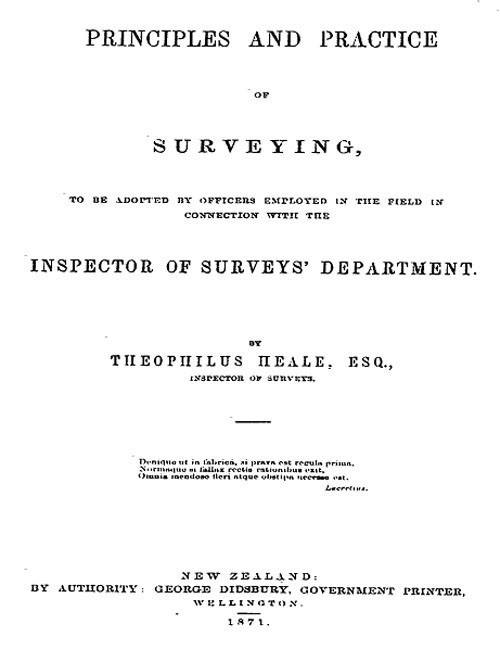
Nor is that all: they [the Maori people] must not be permitted to enter into any contracts in which they might be ignorant and unintentional authors of injuries to themselves. You will not, for example, purchase from them any territory the retention of which by them would be essential or highly conducive to their own comfort, safety, or subsistence. The acquisition of land by the Crown for the future settlement of British subjects must be confined to such districts as the natives can alienate without distress or serious inconvenience to themselves. To secure the observance of this - will be one of the first duties of their Official Protector.
Within the terms of the 1873 Native Land Act every instrument of alienation had to be explained to the Native vendor by an interpreter, accompanied by a fully endorsed statement, describing its contents, in the Maori language.
EPILOGUE
The Reverend John Warren wrote in 1863: ‘I was present at the great meeting at Waitangi when the celebrated treaty was signed, and also at a meeting which took place subsequently on the same subject at Hokianga. There was a great deal of talk by the natives, principally on the subject of securing their proprietary right in the land, and their personal liberty. Everything else they were only too happy to yield to the Queen, as they said repeatedly, because they knew they could only be saved from the rule of other nations by sitting under the shadow of the Queen of England. In my hearing they frequently remarked, "Let us be one people. We had the gospel from England, let us have the law from England."
My impression at the time was that the natives perfectly understood that by signing the treaty they became British subjects, and though I lived amongst them more than fifteen years after that event, and often conversed with them on the subject, I never saw the slightest reason to change my opinion. The natives were at the time in mortal fear of the French, and justly thought they had done a pretty good stroke of business when they placed the British lion between themselves and the French eagle...’ (see, The Treaty of Waitangi, by T.L. Buick pp. 281-282).
In the end it was only the totality of signatures acquired at both Waikato and Manukau Heads, based upon an oral delivery of the Maori text to the assemblies, to which Hobson later affixed his seal, legitimising the signatures. Hobson, thereby, acknowledged the wishes of the chiefs at Waikato and Manukau that their stated desire to cede sovereignty to Queen Victoria was duly noted and would be implemented.
In 1840 the chiefs wove a tapestry of unification that some of their progeny now seek to unravel.
Modern-day activists are, apparently, far wiser than the 540-chiefs who carefully considered, then signed the treaty. They, therefore, feel qualified in telling us that the treaty is, in actuality, something utterly different to what all the chiefs heard, questioned and discussed, then agreed to embrace as the best course to follow for the future prospects of the country.
Martin Doutré, 28 May 2023 ©